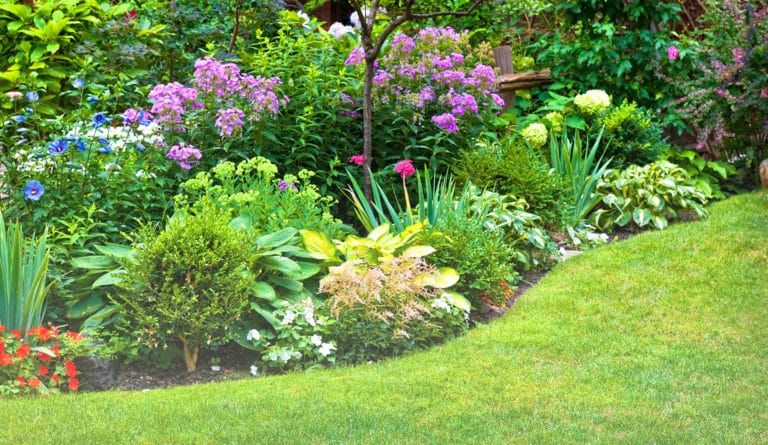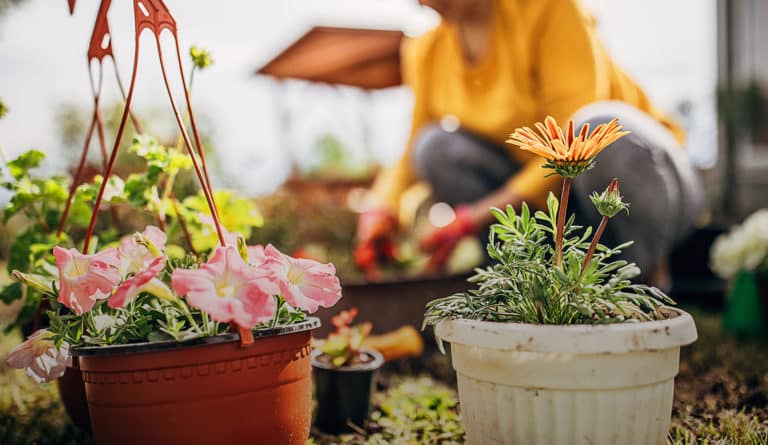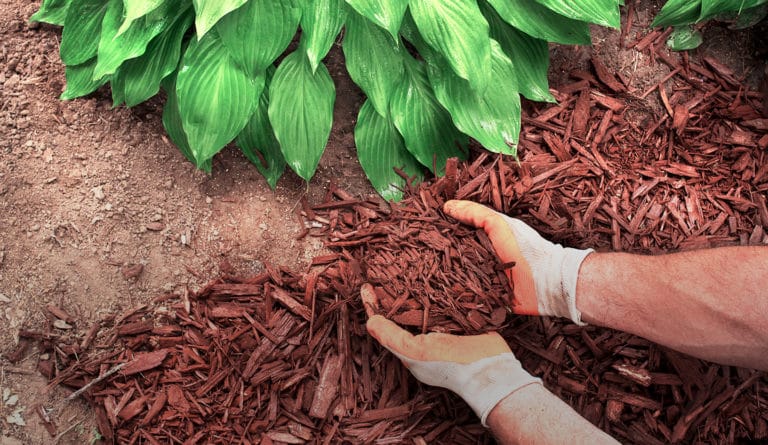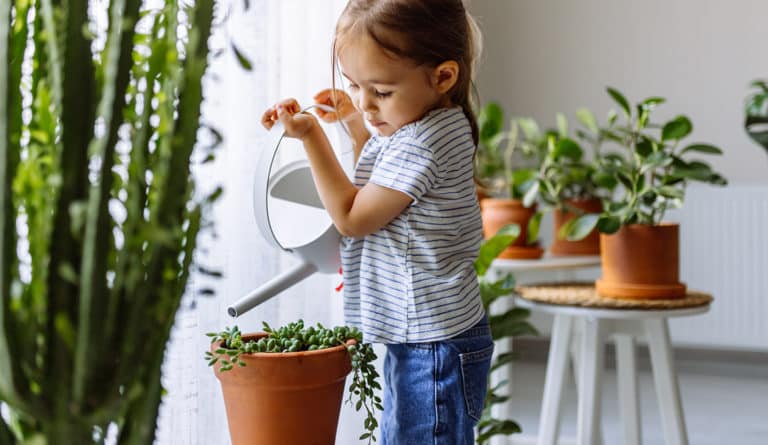- 24” x 48” Good one-side plywood (For 30 propagation stations)
- Tape measure
Straight edge/ruler
Speed square - Painters tape
- Protractor or comparable tool for measuring angles
- Pencil / Eraser
- Test Tubes (20x150mm) Linked here!
- Stain of your choice
- Polyurethane (Optional)
- Mitre saw
- Table saw
- Table saw push tool
- Power drill
- ¾” Spade bit
- Jig saw
- 4” (10) Wood jig saw blade
- Clamps
- String (colour of your choice, I used hemp)
- Yarn needle
- Clear double-sided tape
- Sandpaper
- Electric sander
- Ear protection
- Safety glasses/goggles
- Mask
- Command hooks / Hanging nails
Hello all! I’m Shavonne and I’m back on Plant Project Canada’s page to teach you how to create these beautiful plant propagation stations. This was one of my first-ever woodworking projects and I’m so glad to be able to offer you the highly requested plans to make them yourself! One sheet of 24” x 48” Plywood should make around 30 propagation stations so you’ll have plenty to gift to your favourite people or make an incredible plant wall for your home.
Have you checked out our other projects on Plant Project Canada’s blog? Click the links to the project plans and videos here:
- Garden Planters with Blooming Archway (Article)
- Garden Planters Video
- Light-up Living Plant Wall (Article)
- Light-up Plant Wall Video– Outdoor Holiday Arrangements (Article)
- Outdoor Holiday Arrangement Video
My social channels are Once Upon a Bungalow, and you can find me on Instagram, Facebook, TikTok, and YouTube. We are always up to something in our little bungalow, so please come and join the fun. I am looking forward to seeing you there! Alright, Let’s get building…



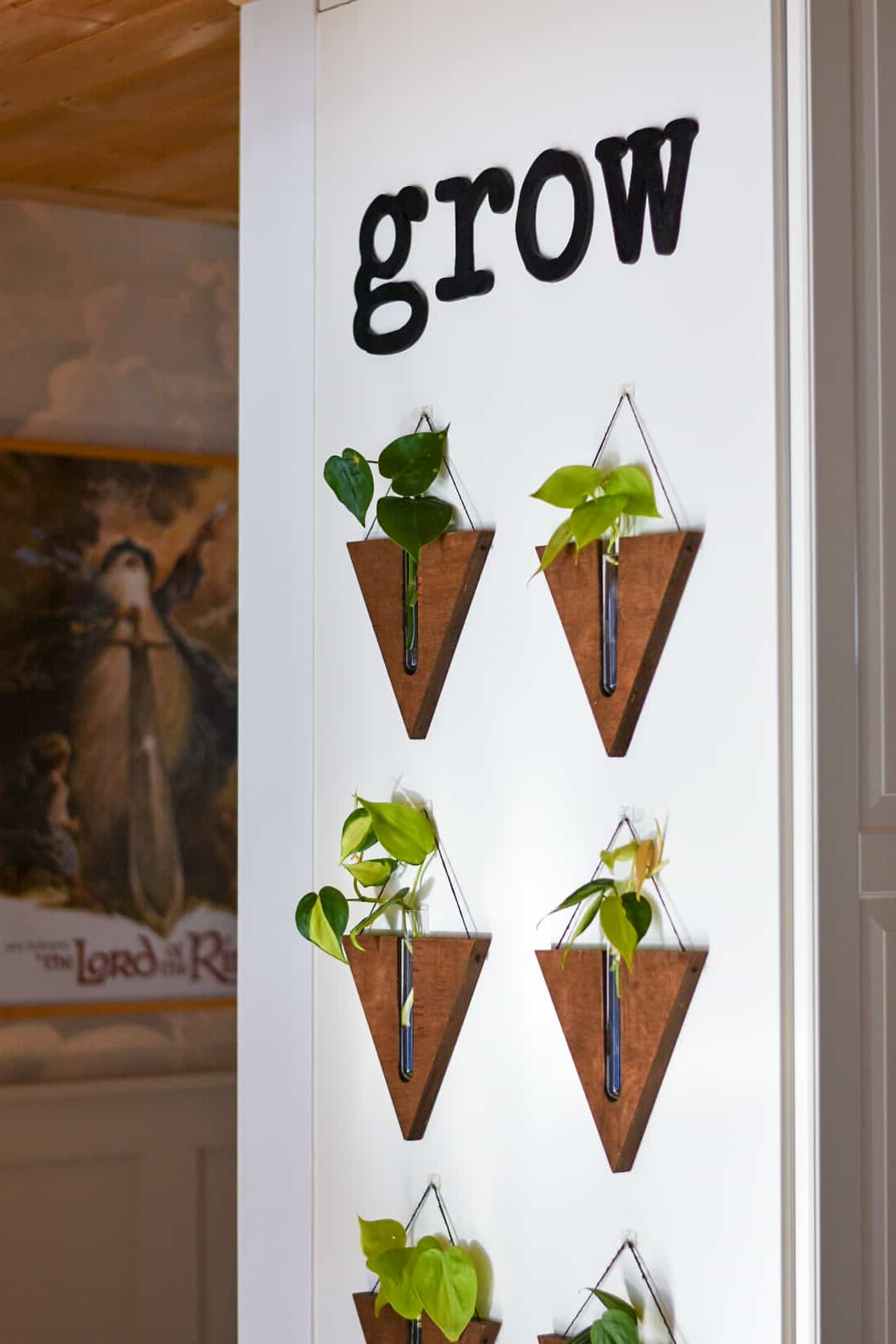
step 1.
Start with a 24” x 48” sheet of good one-side plywood. Mark 8” upwards from the 48” side and use a pencil and a straight edge to draw a line. Continue this to make three lines, all measuring 8” wide. Using a table saw, make three cuts lengthwise along the wood. This will create three strips of 8” x 48” plywood. There will be a few inches extra, discard this, as it’s not needed for this project. Refer to the images below.



step 2.
These propagation stations are cut at a 60-degree angle. This makes each side of the triangle exactly 8 equal inches. Using a protractor (or tool of preference to find an angle), mark the triangle lines at a 60-degree angle. Only measure this angle for one triangle, then use the first triangle as a template for the rest of the propagation stations.
Cut the first triangle using a mitre saw at the exact angle marked on the wood. Flip the wood over, and use the triangle that was just cut to mark the next triangle. This way, there will be no waste and no adjustments to make on the angle of the mitre saw. Continue to flip the wood, mark the angle, cut, flip, mark, and cut! There will be 30, 8” x 8” x 8” triangles. Refer to the images below.



step 3.
Estimate the center of the triangle and place painter’s tape on the front and back of the propagation station. The use of painter’s tape is important for a nice clean cut on plywood. Find the center by placing the speed square in line with the bottom point of the triangle. The center point should be around 4” in the middle of the triangle, but it’s best to measure up from the bottom to find the center.
Using a speed square mark the center point of the triangle with a pencil. Once the center is marked, use a tape measure to mark a ¾” spot for the test tube to fit snuggly into. To make the ¾” spot, measure from the centerline ⅜ of an inch out each way.
Next, measure 5” from the top of the propagation station to find the bottom of the test tube spot on that center line and mark this as well. Place the top of the test tube perpendicular to the propagation station, and on top of the 5” marking to find the exact curve of the test tube, mark the curve with a pencil. Make a straight line by using the speed square overtop of the markings. See the example below of the ideal markings for the 20x150mm test tubes. Refer to the images below.



step 4.
Clamp the propagation station firmly to a work bench on each side. Using a ¾” spade bit in a power drill, make a hole at the bottom of the test tube spot and go completely through the wood. Next, equip the jigsaw with a 4” (10) Wood jigsaw blade. Set the jigsaw to the wood setting. (On a Greenworks Jig saw, this is setting number 3). This blade and setting should give the cleanest cut.
Start at the top of the propagation station and cut as straight as possible following the markings made on the painter’s tape. Cut down to meet the hole cut previously. This will result in a snug test tube resting place. Use a test tube after cutting to check if it fits in the hole snugly. Trim as necessary to ensure the test tube fits. Remove the clamps. Refer to the images below.



step 5.
Remove the tape from the plywood very slowly and carefully. Pull the tape in the direction of the non-cut part of the wood toward the cut part of the wood to avoid the wood from lifting and chipping. Use an electric sander to buff the raw edges, face, sides, and back of the triangle. Next, use a drill with a small drill bit to make a hole on each edge of the triangle. These holes will be used to put string or hemp through to hang the propagation station. These holes will be roughly ¼” in from the edge. Refer to the images below.



step 6.
Stain the propagation stations to the colour desired. A Polyurethane sealant will seal the propagation station for extra waterproofing and durability, however, it’s not necessary. Once the stain is dry, add string or hemp. Use a yarn needle to guide the string through the holes created in the previous step and double knot the string to ensure it is secure and will not slip through the hole when hung.
If making a set of propagation stations, use the first completed propagation station as a guide to making sure the string length is the same and they all look cohesive. Next, cut a small piece of clear double-sided tape and place one small strip of it onto the test tube. Once the double-sided tape backing is removed, place the test tube in the niche created for it. Refer to the images below.






step 7.
Hang them up! Using clear command hooks or hanging nails, hang the propagation stations. To propagate a plant, such as a pothos, take a healthy section of the plant stem, typically 4-6 inches long, just below a node (where leaves are attached). Remove the leaves from the lower half of the cutting, and place the cutting in the propagation station with water in it.
you’re done!
Within a few weeks, there should be some root growth in the test tubes. Once there is substantial root growth, transplant with Miracle-Gro® Indoor Potting Mix. This lightweight mixture will help the roots spread out and further form. To give the cuttings the nutrients they need to thrive, try Miracle-Gro® Quick Start Fertilizer Planting and Transplant Starting Solution. This starting solution will improve root growth and give the plant the ability to grow big and strong.
There you have it, plant propagation stations! I hope you enjoyed this tutorial. For my propagation wall, I added a wooden cutout of the word “Grow.” This was ordered from a small Canadian business, Knotty Design Co.
Thank you so much, Plant Project Canada for having me once more! I look forward to seeing all of the Propagation stations you create! Be sure to tag me in your creations. Thank you for stopping by!
Xo Shavo






#happycreating!
Hello Everyone! My name is Shavonne and my social channels are called Once Upon a
Bungalow. I’m so happy to have been invited to Plant Project Canada’s webpage to share a
how-to on this very exciting project. This time I have instructions on how to build our Light-Up
Living Plant Wall. Check out our video for this project here! This project is for beginner to
intermediate woodworkers and is a great way to display your plants outdoors in the day or in the
evening. In case you missed it, click here for my instructions on making Planter Boxes with a
Blooming Trellis Archway, my first article with Plant Project Canada.
These instructions are based on our backyard living wall, feel free to adjust the
measurements to fit your space appropriately. Alright, Let’s get started on this unique and
whimsical plant wall…Here we go!


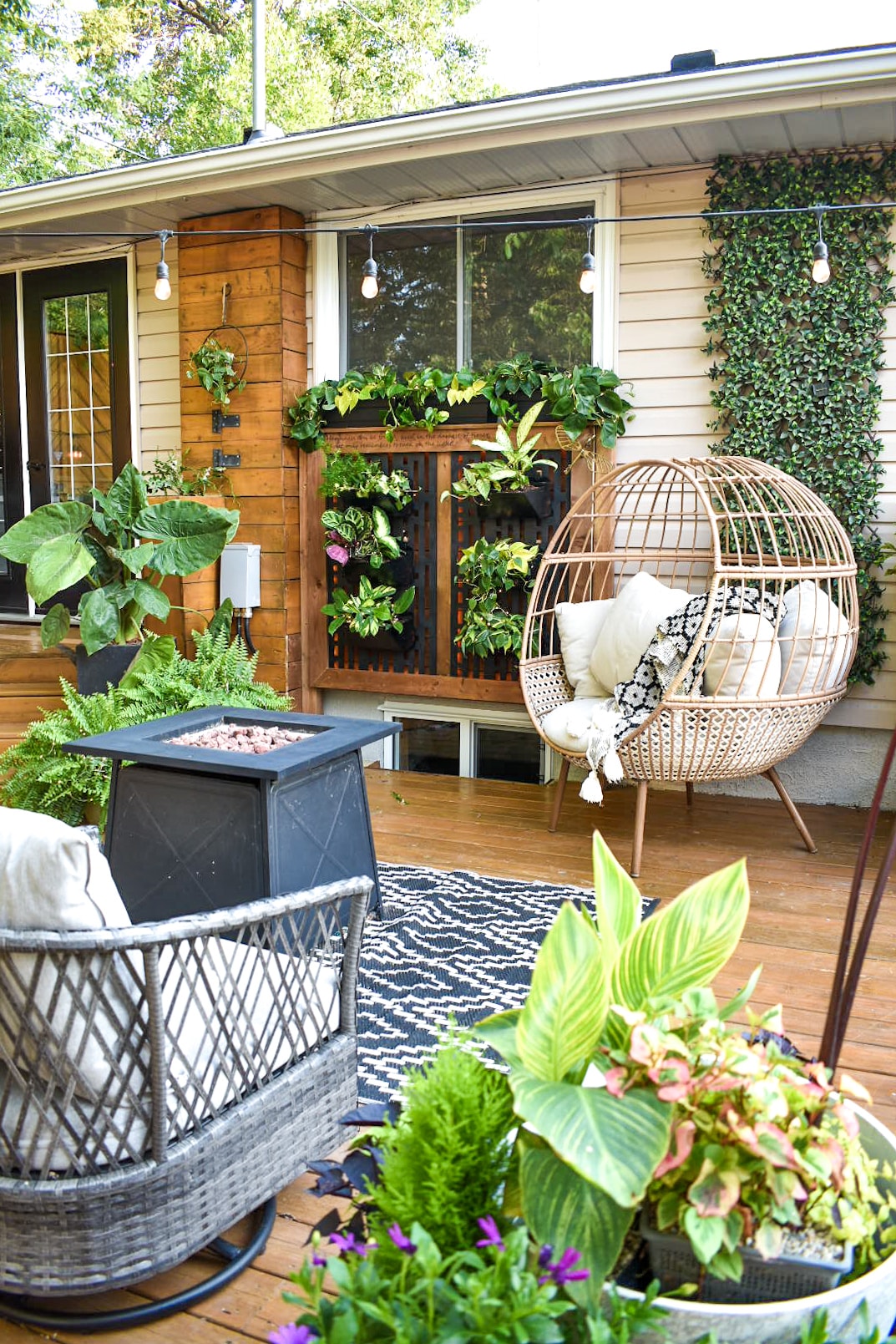
Here’s what you’ll need:
Material list:
– 1 ¾” Deck Screws
– 3 ½ ” Deck Screws
– 2 – Pressure-treated 4×4’s (8’-0” Long)
– 4 – Pressure-treated 2×4’s (10’-0” Long)
– 12 Pressure-treated fence boards (10’-0” Long)
– 2 Black Acrylic Privacy Panels (2’-0” x 4’-0”)
– 6 Hanging Plant Pots (I used metal plant pots)
– 3 Rectangle Plant Pots (For the top, these can be any pots you like!)
– Stain and or Paint
– LED Strip Lights (65.6ft, self-adhesive)
– 12 Metal Flower Pot Clips (Typically used for hanging clay pots on a fence)
– Optional: Vinyl cut out with a quote of your choice (This adds some magic to the project!)
– Plants! (I used all tropical plants that can be brought indoors in the winter)
Tools:
– Table Saw
– Metre Saw
– Tape Measure
– Various Clamps
– Speed Square
– Drill
– Impact Driver
– Pencil
– Level
step 1.
Creating the sides of the base to the Plant Wall: Cut two 4x4s at 65 ¾” on the metre saw and toenail these with four 3 ½” screws into your deck. Use a level to ensure your 4x4s are straight. Note: If creating a living wall on the ground, dig your 4x4s 3’-0” into the soil and anchor it with gravel or concrete. Add 3’-0” to the 65 ¾” measurement above. See the images below.



step 2.
Add 1 ½” x 1 ½” to the 4x4s to create an inset space to attach the fence boards: Next, take a 2×4 and cut it in half on the table saw lengthways, creating two 1 ½ x 1 ½ pieces. Cut these 1 ½ x 1 ½ pieces at 51” on the metre saw. Attach these vertically flush with the back and top of your 4×4 pieces. Anchor these with 3 ½” deck screws, every 12” forming a base for the fence boards to be screwed to. Once these pieces are in place on both sides, find the measurement inside of the 4x4s. See the images below.



step 3.
Add your fence boards: Measure from inside the 4×4 space and cut your fence boards to fit. Use a level to ensure the top board is straight. Attach fence boards on the outer edges with two 1 ¾” screws with no spaces between each board. Our fence boards were cut at 57 ¼”. We used 9 fence boards going
horizontally down, as we had a window we didn’t want to cover. If desired, boards can extend to the ground. See the images below.



step 4.
Make a frame for the black acrylic privacy panels to be attached to: Use your 2x4s to create a frame for the black acrylic privacy panels to be attached to. Cut the top and bottom pieces first at 57 ¼”. Place these two pieces at the top and bottom (flush with the top fence board and flush with the last fence board attached on the bottom.) Attach with two 1 ¾” deck screws on the ends of the board, toenail the sides to secure the boards. Cut three 2×4 pieces at 44”. Place 2 of the 44” 2×4 pieces on each side, snug beside the 4x4s and attach with two 1 ¾ deck screws on each side, along with a toenail screw on the sides. Next, find the center, use a level to ensure the board is straight, and then attach the third 44” board by using two 1 ¾” deck screws on both ends and then toenail the sides again until secure. See the images below.



step 5.
Add the LED Strip lighting: Drill one small hole in the bottom inner corner of each frame for the cord of the strip lights to go through. Attach self-adhesive LED strip lights around the inner edges of the frame you just made. With a 65.5ft pack of LED lights, which is sold in two separate sections, I wrapped the
LED lighting around the inner edge of the frame three times. Run an extension cord behind the plant wall to plug in the strip lights, and tuck any cords up behind the project to hide them from sight. See the images below.






step 6.
Add blocking to the plant wall to support the hanging plant pots: The plant pots need something strong to hold on to, as they cannot hang off the black panels alone. We used six hanging wall pots and needed two rectangular pieces behind each pot to act as studs behind each pot. Cut the remaining 1 ½” 2×4 pieces into twelve 3” rectangles. Attach “stud pieces” with two 1 ¾” deck screws in places that align with the plant pots required in the placement desired. Get creative and design your own unique placement, or feel free to copy ours! See the images below.



step 7.
Attach the black acrylic privacy screens: Next up, the black panels! Using four 1 ¾” deck screws for each panel, attach the black panels to the frame at the top and bottom. See the images below.


step 8.
Attach the hooks to hold the plant pots: Take 12 metal flower pot clips and attach each clip with one 1 ¾” deck screw to the blocking behind the black panel. If the design pattern of the black acrylic panel doesn’t work out to lay directly in front of your hook, use a washer to shim out the space and attach your plant clip. If two hooks are required for each pot, use a level to ensure you are creating a straight line that your pot will hang upon. See the images below.





step 9.
Add the outer frame and top piece to finish off the look: Using a table saw cut 2 fence boards to 4” in width. Cut two pieces with a 45-degree angle using a metre saw at 58” and two pieces at 50 ½” to form a border around the black panels securing them in place and creating your trim work. Secure these to the plant wall with 1 ¾” deck screws. Cut one fence board at its original width at 64” in length to create the top and final piece of wood to the plant wall. Place on top and secure downwards with 1 ¾” deck screws. See the images below.





step 10.
Add the plants: For our plant wall, I went with all tropical plants that I could bring inside during the winter months. The plants I chose include different variations of pathos, prayer plants, snake plants, and other various tropical plants. To ensure these plants stay happy in the summer heat, and with my tendency to over-water, I chose to use Miracle-Gro® Moisture Control Potting Mix. This soil helps you protect your plants from over and under-watering! It absorbs 33% more water than your basic soil and releases it as the roots need it. It’s also nutrient-rich and contains a slow-release fertilizer within the soil to provide those essential nutrients to your plants over time. Moisture control Potting Mix also helps with airflow within the dirt, giving the roots the oxygen they need, which is essential for the plant’s development and vitality. See the images below.



step 11.
Add personal touches and details: I added a vinyl sticker featuring a quote about light from our favourite book series. I thought this quote suited the project as it lights up beautifully at night. 10 points to Gryffindor if you can recognize where this quote is from! I also added a metal flying key to add more whimsy and personalization to the project. For extra glowing magic, add fairy lights to each plant! See the
images below.



There you have it! That’s how you can build your very own plant wall. I hope you enjoyed our
tutorial. Please tag @PlantProjectCanada and @OnceUponaBungalow if you do create one too.
Find my family and me on all socials under the name “Once Upon a Bungalow.” Thank you to
Plant Project Canada for having us on the blog again, we loved creating this how-to! Check out
more images from this project below.
Happy Planting!
Xo Shavo
Follow Shavonne on Instagram and TikTok





#happycreating!
A transformation happened! Our backyard living space was completely changed.
Initially, our goal was simple: build a deck to host family BBQs and birthday parties. But what we didn’t realize was how quickly we’d fall out of love with it. In just one year, the deck went from being our favourite lounge spot to a big, wooden pathway. This was especially tough for me since I had put my heart and soul into building that deck.
I take a lot of pride in my property, so I needed to breathe some new life into my once-beloved deck. And then it hit me – we needed something natural to break up the straight lines and dead wood. I spend most of my time building gardens for people passing by my house, but I had neglected the space I built for my own family. So, one day, while topping up my porch planters with some Miracle-Gro® moisture control potting soil and Miracle-Gro® plant food, I had an idea. We needed planters to bring life and contrast to this barren wooden platform. Since our deck had no rails or border, we decided to create some planter benches for both functionality and beauty.
Here’s my step-by-step guide on how to create your own planter benches. This project is designed to be modular, repeatable, and simple enough for even a beginner DIYer with minimal tools. We’ll walk through constructing two planters and one bench, but you can expand or reduce the project to fit your space. That’s the beauty of this design.


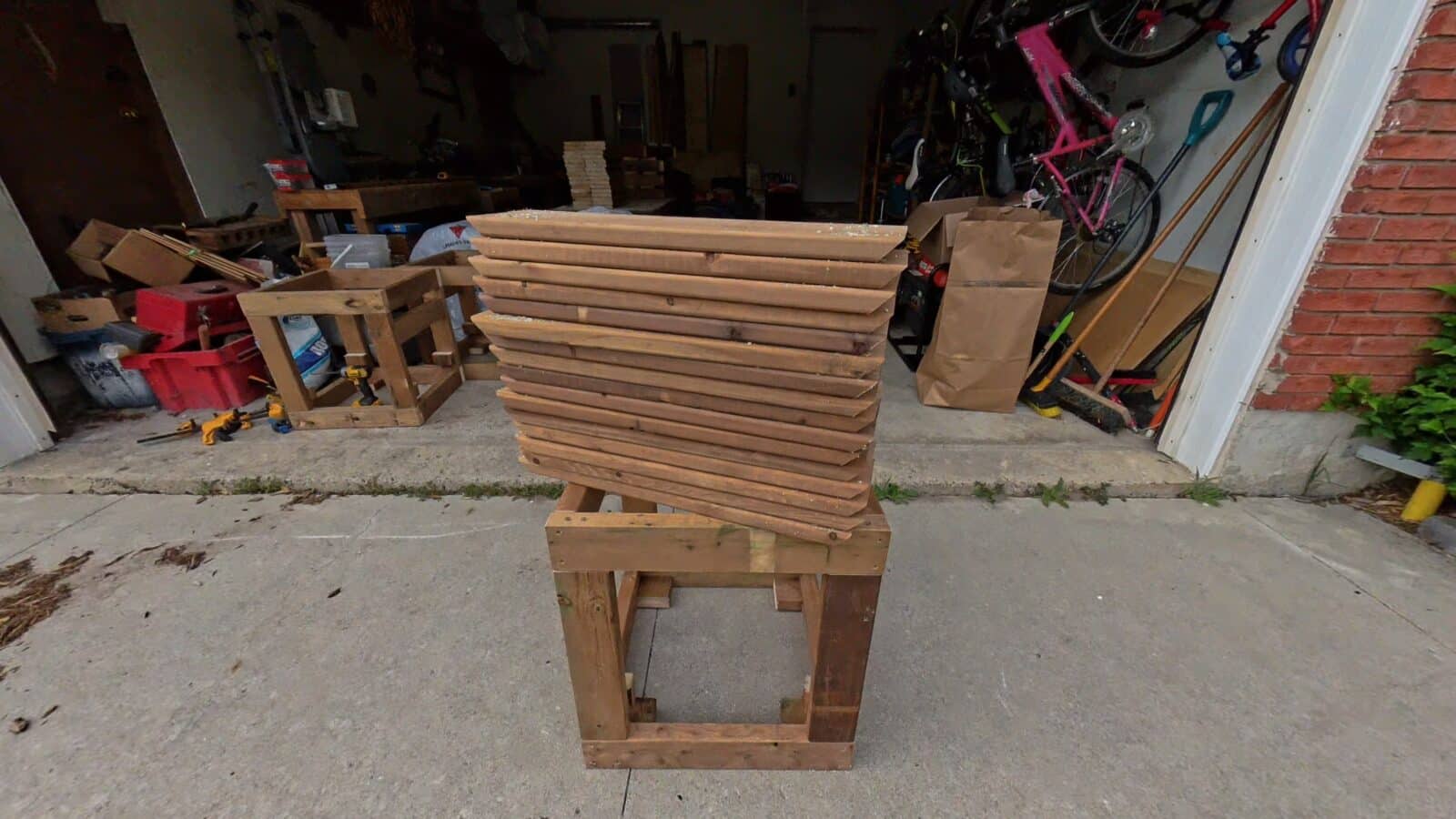
Here’s what you’ll need:
Tools You’ll Need
Clickbait alert! “You can complete this project with a screwdriver, a saw, and a measuring tape!” While that’s technically true, here’s a more comprehensive list of tools I suggest:
- Measuring tape – Must have. You’ll use it a lot.
- Drill – I used two: one for drilling pilot holes and one for fastening.
- Saw – Essential. You could bring the cut list to your local lumber dealer, but I suggest cutting your own wood to ensure accuracy and reduce waste.
- Level – To make sure your benches don’t slope.
- Drill bits / pencil – Necessary for the fasteners listed in the materials section and for marking measurements.
Nice to have:
- Second drill for pilot holes – This prevents wood from splitting. You can swap bits if you only have one drill.
- Speed Square – Makes measuring and marking easier.
- Chop Saw / Miter Saw – A big upgrade for cutting wood, great for making repeat cuts.
- Clamps – Handy when you need an extra pair of hands and you’re working alone.
Materials You’ll Need
This guide will yield one bench and two planters:
- 2×4’s, 8 feet long (qty. 15) – Pressure treated or rot-resistant wood like cedar for longevity.
- Deck Boards, 8 feet long (qty. 10) – Must be pressure treated, typically labeled 5/4 x 6.
- 1 ½ “ Deck screws (qty. 144) – Exterior grade. Buy a box; they’re handy elsewhere. Used only for fastening deck boards.
- 2 ½ “ Deck screws (qty. 104 ish) – Exterior grade. Buy a box; they’re handy elsewhere.
- 4” Framing screws (qty. 40) – Exterior grade. These make siding the planters simpler and provide a strong structural hold.
- 15” Square plastic planters (qty. 2) – For easy maintenance and to protect the wood.
Cut List
I’ve broken the build into components for easier assembly. Make these cuts and label them for later. I suggest making all the cuts before starting assembly.
Planters x2
Platform:
- [2×4] – 4x 17.5”
- [2×4] – 4x 14.5”
- [Deck board] – 4x 17.5”
Uprights:
- [2×4] – 8x 16.5”
Supports:
- [2×4] – 2x 18”
Squares:
- [2×4] – 4x 18”
- [2×4] – 4x 21”
Siding:
- [Deck Board] – BEGINNER 16x 23” & 16x 21”
- [Deck Board] – INTERMEDIATE 32x 23 1⁄8 (These should be cut with a 45-degree miter on both sides)
Bench
- [2×4] – 2x 17”
- [2×4] – 6x 48” (This assumes a 4-foot-long bench but can be altered to fit your space)
The Full Build Walk-Through
step 1.
Start by building the platform pieces. These are the most forgiving and a great introduction to the rest of the build. Turn the 2×4 components into a square by fastening the two 14.5” pieces inside the 17.5” pieces. Use 2 screws at each joint with pilot holes (implied for each joint moving forward). Ensure you’re fastening through the 17.5” piece into the 14.5” piece, creating a 90-degree angle. Attach the two deck board pieces to the top of the square and repeat. Set aside for later. [16x 2 ½“ screws & 16x 1 ½“ screws]

step 2.
Build 4 more squares. This will be the beginning of your planter. Fasten two 18” pieces and two 21” pieces to create a square, just like the platform square (longer cuts on the outside). Repeat 4 more times. [16x 2 ½“ screws per planter]

step 3.
Combine two squares from the previous step with four 16.5” upright pieces to create a box. Using the 4” framing screws, drill down through the 21” pieces into the 16.5” uprights, creating a 90-degree angle. Repeat until all 4 uprights are installed, creating your planter skeleton. Make 2 of these. [16x 4” framing screws per planter]


step 4.
Measure 18” up from the bottom of the box for the bench height. This will be the top of your bench support. Fasten the bench support so the top of the 2×4 is at 18” from the ground. [4x 2 ½“ screws per planter]
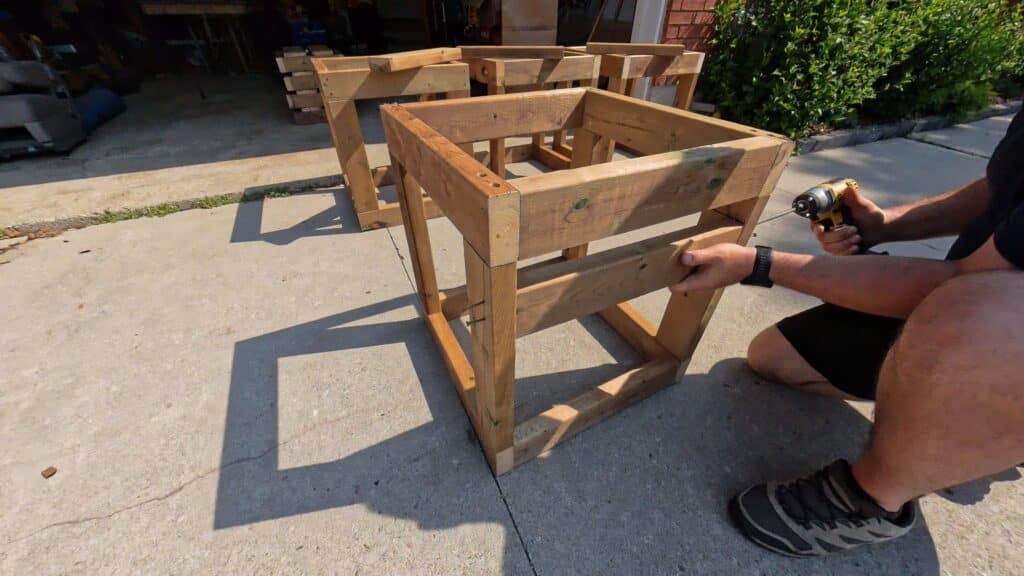
step 5.
Create feet on the bottom side of the planter box to anchor it to the deck. Use 2×4’s of approximately 3” length and fasten them to the inside of the bottom square from the outside with 3 screws per foot. [12x 2 ½“ screws per planter]
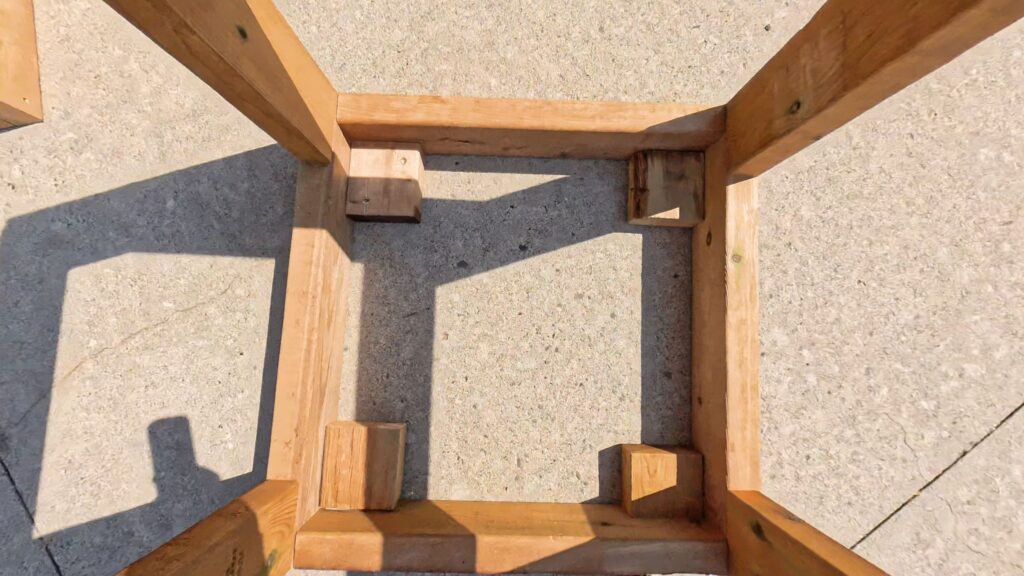
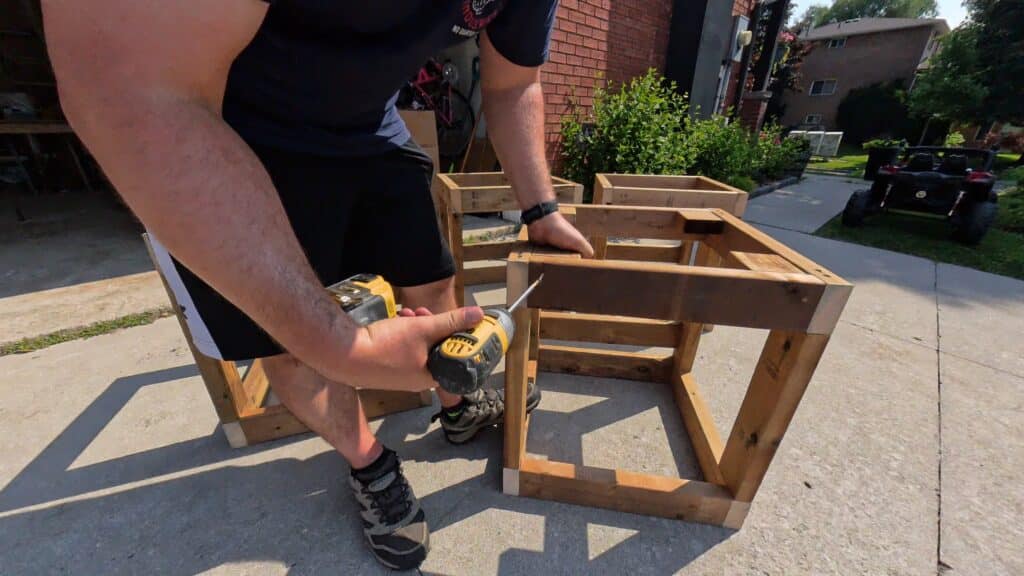
step 6.
Set your platform blocks. This makes the build customizable to plastic planter pots up to 18”. Measure 16.5” down from the top of the planter box. This ensures the 15” planters sit flush with the top of the box. Repeat on all 4 uprights. [8x 2 ½“ screws per planter]

step 7.
Now for the siding. This is when you feel like you’ve truly made something. I chose a miter joint, which might be more challenging but looks great. Set your top boards first, ensuring the inside of the miter joint is in line with the corner of your box. For beginners, make 4 more squares, fastening the deck boards to the box to form a square. Set your top boards first and move down, fastening all 16 deck boards. [64x 1 ½“ screws per planter]

The hard part is done, and you’ve created 2 planters. Now, let’s move on to the bench.
step 8.
Using two 17” pieces and six of the pieces cut to your desired length, ensure the boards are all showing the narrow side. Create a rectangle using the two 17” pieces and two of the length pieces, fastening through the 17” pieces. The remaining four length pieces should fit perfectly in this rectangle with equal spacing of a 2×4. [24x 2 ½“ screws]


step 9.
Mount the bench between your 2 planters using a level. Fasten the bench to the planters using the 4” framing screws from inside the planter through the bench support and into the 17” end pieces of the bench. Ensure the bench height matches the supports at 18”.


This project will add much-needed seating and plant life to your deck or patio. I hope you enjoyed the guide. Happy planting!
Follow @brandonkoruna on Instagram and TikTok for more garden tips!



#happycreating!
DIY planter boxes
Hello Everyone! My name is Shavonne and I’ve popped over to Plant Project Canada’s webpage
from Once Upon a Bungalow with instructions on how to build planter boxes with a stunning
blooming trellis archway. This is a great beginner woodworking project and the final result will
have you beaming with pride.
If you already have two planters that will work for this project and only want to build the
archway, scroll past the planter instructions to find the arch instructions. However, if you’re like
me and love a good DIY project, follow along with these instructions to build the planter boxes
too!
Here we go!


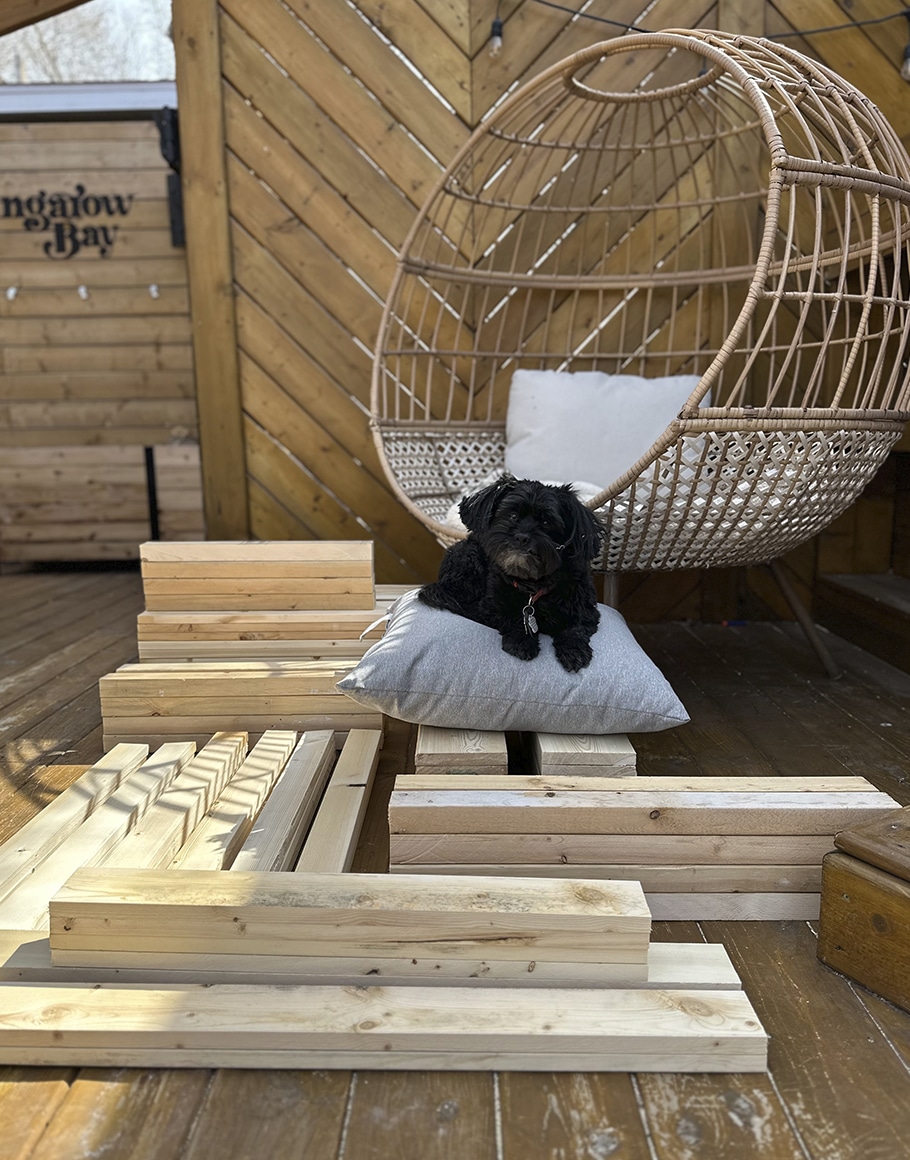
Here’s what you’ll need:
These planter boxes are ideal for raised vegetable gardening as they are deep and have ample soil space for your rooted vegetables to thrive.
The below instructions will build two planter boxes. Each finished planter box will bed 39” W x 26 ½” H x 26” D. I used non-pressure-treated pine to create my planters, but this can be substituted for any ideal preferred type of wood. Start by cutting all the pieces first, to save time throughout the build.
materials:
– 1 ¾” Deck Screws
– 2” Deck Screws
– 1 ¼” Brad Nails
– 32 Pine Fence Boards (1”x 6” x 6’-0”)
– 6 Pine Boards (2” x 2” x 8’-0”)
– Sandpaper
– Wood Glue
– Wire Mesh
– Stain and or Paint
tools:
– Table Saw
– Mitre Saw
– Brad Nailer
– Tape Measure
– Various Clamps
– Electric Sander
– Jig Saw
– Speed Square
– Pocket Hole Jig (Optional)
– Staple Gun
cut list:
– 8 2×2’s at 26” (Leg’s)
– 4 2×2’s at 22” (Side Supports)
– 4 2×2’s at 22 ½” (Bottom Supports)
– 4 2×2’s at 20 ¼” (Bottom Supports)
– 24 Fence boards at 35” (6” width) (Long sides & bottom of the planter)
– 16 Fence boards at 24” (6” width) (Short sides of the planter) *Tip: Use a table saw to cut the following pieces at 2 ½” width first, for less material waste.
– 16 Fence board pieces at 26” (2 ½” width) (Side Trim)
– 4 Fence board pieces at 38 ¾” (3” width) (Top Trim)
– 4 Fence board pieces at 26” (3” width) (Top Trim
step 1.
Making the long sides of the planter box: Take 4 of the 35” fence boards and lay them out on a flat surface. Use clamps to press the four fence boards together for an even and taught placement. Place the 26” 2×2’s on either end of your 4 boards, with the top of the 2×2 flush with the top of your planter—the remaining length of the 2×2 will overhang. Use wood glue on the back of the legs. Use clamps to secure the legs in the right position before anchoring them with screws. Once the legs are in place, pre-drill holes and then use 1 ¾” deck screws to secure the legs. Find the center position using a tape measure, and place the 22” middle support using the same process of wood glue, clamps, pre-drilled holes, and screws. Repeat step one 4 times. See the images below.



step 2.
Attaching the short sides of the planter box: Lay one of the completed “long sides” on a flat surface to begin attaching the 24” fence boards to the 2×2 leg on the “long sides” assembled in step one. Attach these boards flush, use wood glue, pre-drill the holes, and then secure with 1 ¾” deck screws. Continue attaching until all four 24” pieces are attached. Once complete, attach the other completed “long side” to the other end of the 24” piece. Complete the box by adding the 4 remaining 24” pieces to the opposite end. Use a speed square to ensure all corners of the box are at a 90-degree angle. See the images below.



step 3.
Bottom supports: Measure 8 ½” over on the “long side” from each 2×2 leg. Attach the 22 ½” 2×2’s from the outside by using wood glue, pre-drilling, and then using 2” inch deck screws. The 22 ½” boards may have to be trimmed to fit in this space (That’s okay!). There will be another support between the legs of each of the “short sides” of the planter. The 20 ¼” 2×2’s should fit snuggly between the two legs. Use a pocket jig to pre-drill the holes to attach these, or toenail screw from the front side. See the images below.



step 4.
The planter’s bottom: Using the remaining 35” fence pieces, place one piece in the base of the planter box. Press these boards up against the sides until they are snug. Mark where the legs butt up against the fence piece. Mark these locations with a pencil on the fence piece. Measure the length that the leg protrudes into the box and measure this distance onto the fence piece. Use a Jig Saw to cut out these notches. There may be space between these boards, which is okay, as it will allow for drainage in the planter. See the images below.



*Note: Once I was at this stage of the build, I took the time to stain the planter box with an outdoor deck stain. I then painted the side trim pieces in black before attaching them to the planter boxes. * Tip: Having a friend with you helps speed up the process! See the images below.



step 5.
Side trim pieces: Attach the 26” side trim pieces using wood glue and 1 ¼” brand nails. Place the first trim piece on the “short side” flush with the edge. The piece should sit flush with the ground and flush with the top of your box. Then place another trim piece on the “long side” of the planter, glue, and then brad nail. Repeat this process on each corner of the garden box. Use wood filler to fill in all brad nail holes, sand, and then touch up paint. See the images below.



step 6.
Top trip pieces: Cut the 26” fence pieces with a 45-degree angle to frame the top of the garden boxes. Using wood glue and a brand nailer, attach each of the pieces, only after arranging all 4 pieces on the top to ensure an even trim for the top of the planter. Use wood filler to fill in all gaps and brad nail holes, sand, and then touch up the stain of the top trim. See the images below.



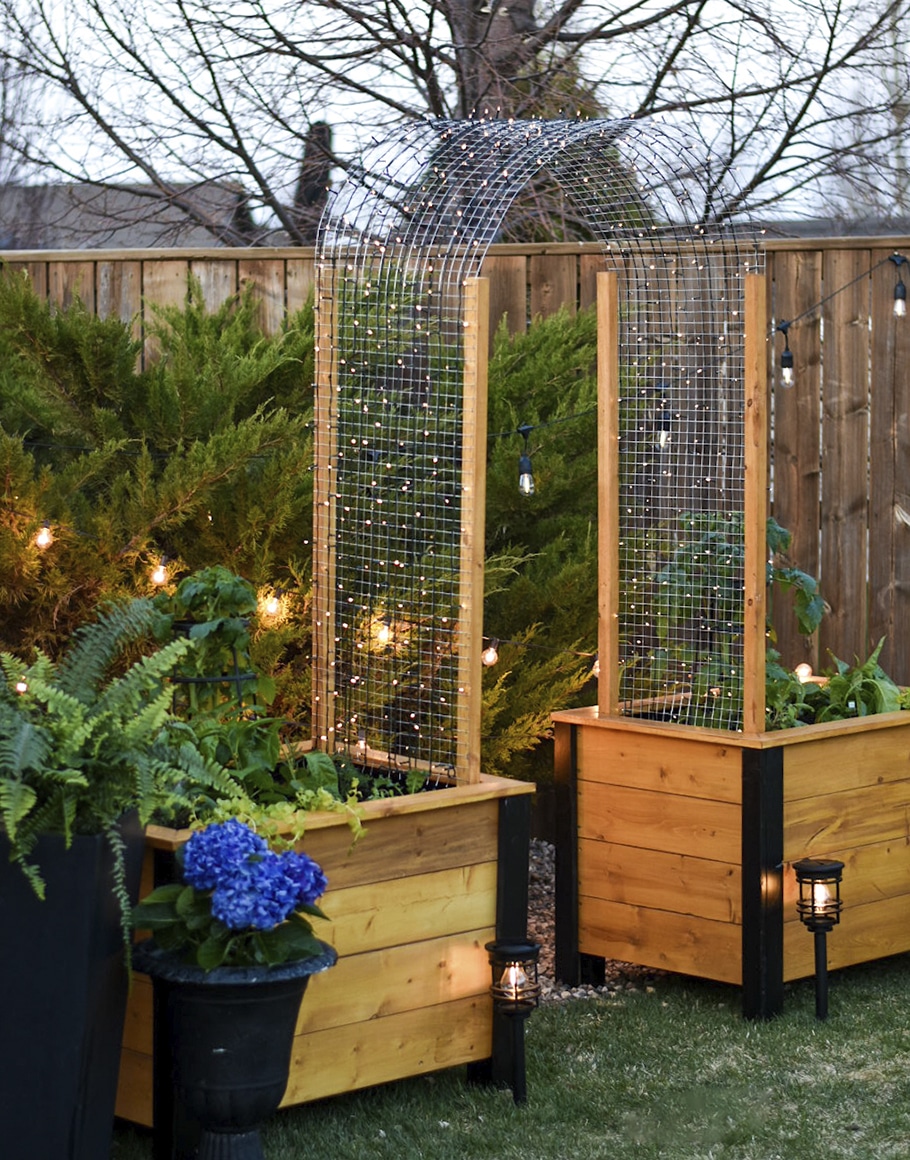
DIY planter boxes arch trellis
step 1.
Creating the supports: Cut 2×2’s at the desired height. 62” inches is the height of the supports shown in the image below. Stain or paint the supports to match the design cohesively. Attach supports to the 2×2 legs inside the planters using 1 ¾” deck screws. 3 screws in each support should be sufficient. See the images below.



step 2.
Adding the wire mesh: Measure the distance between the two supports. Using that measurement cut the wire mesh to size. Start below the trim of the planter box and attach the wire mesh to the supports using construction staples. Remember, the mesh doesn’t have to go all the way down into the box, it just has to begin at soil level.



step 3.
Light it up: Using solar lights, string the lights over the archway to create a stunning glowing effect in the early months of spring before the trellis fills in with your gorgeous climbing plants.



DIY planter boxes with arch trellis tips & tricks:
- Fill the planters with sticks, grass clippings, and leaves before adding the soil. This will naturally enrich the soil over time and it will take up space in each planter, costing less to fill.
- Use both Miracle-Gro Garden soil and potting soil. Using a 50:50 blend of these two soils will provide a lighter, more suitable mix for raised bed plants to thrive.
- Use Miracle-Gro Shake n’ feed to give your garden a boost and remember to fertilize every week as this makes all the difference.
I’m so honoured to be a guest on Plant Project Canada’s blog, and I look forward to seeing all of
the planters and trellises you create! Be sure to tag me in your creations. Thank you for stopping
by!
Xo Shavo
Follow Shavonne on Instagram and TikTok


#happycreating!
are you looking to spruce your outdoor space with a unique and creative garden? Look no further than creating your own vertical garden!
Vertical gardens are the perfect way for gardeners of all skill levels to create aesthetically pleasing and eco-friendly backyard decor that brings an extra level of life, colour, texture and personal expression into any outdoor living area. Plus, they can provide fresh herbs, fruits, and veggies right in your kitchen. How cool is that?
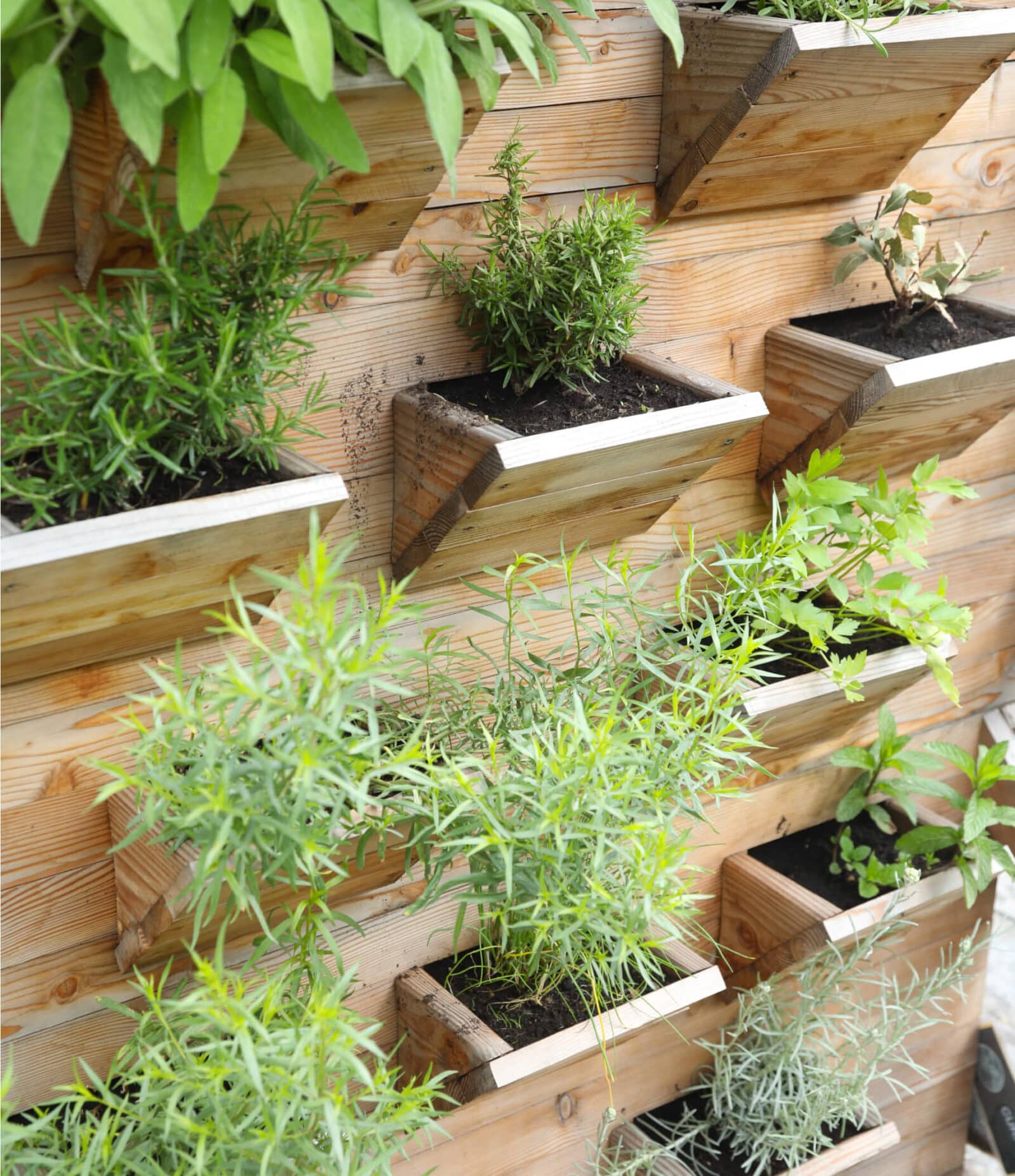
starting your vertical garden journey
If you thought a vertical garden was only for large backyards, think again! They are perfect for smaller spaces like balconies too. You can design them any way you like and choose the plants that suit your fancy. With a vertical garden, you’ll have a touch of nature and beauty at your doorstep. So, what are you waiting for? Let’s get gardening!
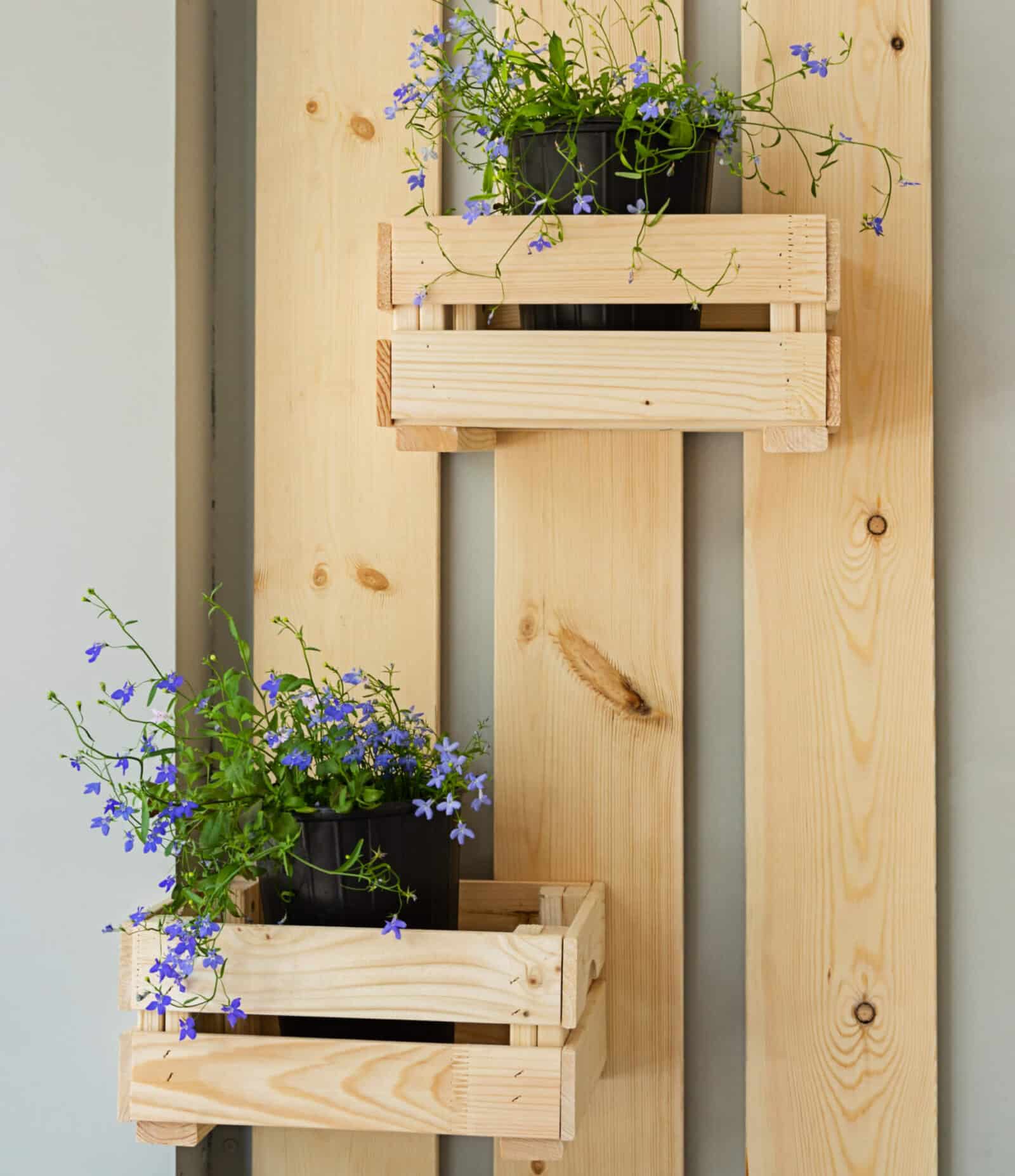
here’s what you need
If you’re into vertical gardening, let’s get your plants up and growing! First things first, you’ll need some supplies. Grab yourself a vertical planter or frame – it’s like a fancy framework for your plants to climb on. You can buy one from a garden store (think trellis or wooden ladder) or get creative and use what you already have, like your deck or fence. Feeling crafty? Build your own and make it totally unique to your yard and plants. You can use nursery pots within your vertical structure, similar to the ones featured here. For a bit of a different look, use clay or painted pots. Whatever pot you choose to use, make sure there’s ample drainage.
choosing the perfect plants
With so many different plants to choose from, how do you know which ones are right for you? First, think about how much sunlight your space gets. Some plants, like succulents and ferns, are great with less light, while others, like herbs and veggies, crave that sweet sunshine. Before you get too carried away, decide if your garden will be indoor or outdoor. Also, consider the size and weight of your plants. If they’re big and heavy, they might need some extra support. It’s also essential to consider the aesthetic you want to bring to your garden. Do you want that lush, leafy look, or are you more into the sleek and modern vibe? Keep all this in mind before you dive into the world of vertical gardening.
nurturing and nourishing your vertical garden
Once you’ve got your plants, it’s time to pick the perfect soil. Our top recommendation? Miracle-Gro® Moisture Control Potting Mix – it’s jam-packed with all the essential nutrients your plants need to thrive. Bonus points for this potting soil because it helps to regulate the moisture in the soil, and protects your plants from over and under watering. Regular watering and pruning are vital to keeping those pesky diseases at bay and promoting healthy growth.
Speaking of watering, maintaining a vertical garden can be a challenge, but investing in a drip irrigation system is a game-changer. It ensures your plants get an even dose of hydration without one area getting drenched. Smart, right? Oh, and let’s not forget about lighting. If your wall is a bit shady, no worries! You can always go for plants that don’t need as much sunlight. Or, if you’re feeling fancy, supplement with some cool artificial light.
revitalizing the environment and your health
Vertical gardens are fantastic for so many reasons! First, they’re like superheroes for the environment because they absorb carbon dioxide and other pollutants from the air while giving us clean oxygen in return. Plus, they’re like magical noise blockers, shielding you from those noisy neighbours and giving you peace and quiet. But that’s not all! You’ll have your own organic produce parade with a vertical garden. Think about it – fresh yummy fruits and veggies, growing all within reach! And here’s the cherry on top: gardening is the ultimate stress reliever. So, when you add a vertical garden to your outdoor space, you’re not just taking care of your health and the planet but also putting a smile on your face. It’s a win-win!
Whether you have a tiny apartment or a spacious house, a vertical garden is a fantastic chance to bring joy to your outdoor space! Plus, you don’t need to break the bank. Many folks have been pleasantly surprised to discover that this seemingly intimidating project is totally doable! So, if you’re looking for some cool ideas to live a greener life, why not try a vertical garden? Trust me, it’s worth it!
#easypeasy
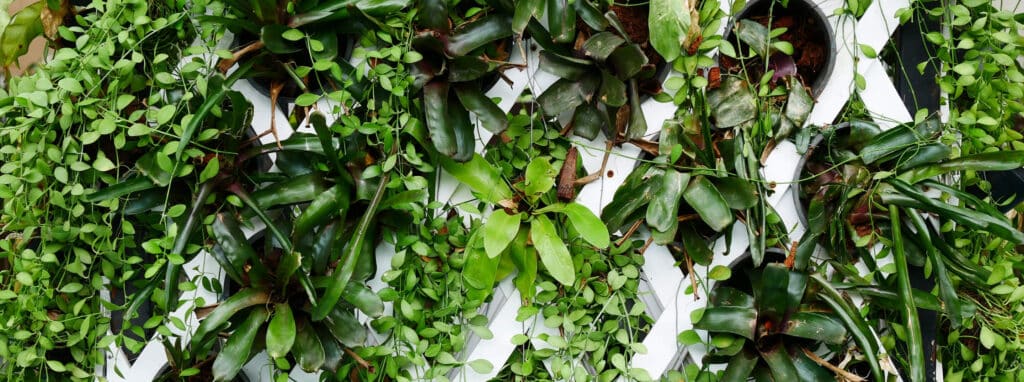

snapdragons
aka antirrhinums, dragon flowers, and dog flowers
Snapdragons are a beloved choice for cottage gardens and perennial flower beds, adding charm and beauty to any landscape. These flowers possess a unique charm with their dragon-like flower heads and a stunning range of colours including white, yellow, pink, orange, and purple.
variations
Tall snapdragons, Dwarf snapdragons, Twining snapdragons (climbing snapdragons), and Angelonia snapdragons.
light
full sun
For best blooming results, make sure they receive at least 6 hours of direct sunlight daily.
water + feeding
thirsty
Snapdragons are somewhat drought-tolerant and prefer a good drink followed by a period of dryness.
toxic
yes
While Snapdragons are safe for humans they can lead to an upset stomach for furry friends.
size
it depends
Snapdragons come in different sizes depending on the variation. On average, they grow between 1 and 3 feet tall. Dwarf varieties only reach up to 10 inches, while larger species can reach 4 feet.
pro tip
give them room to bloom
Snapdragons like to have a bit of personal space. Make sure to leave about 6 to 12 inches between each plant to provide ample space for them to expand and thrive. Plus, it can actually help prevent the spread of diseases. These aren’t wallflowers—they like a little room to show off their vibrant blooms!
fun fact
snap it open!
The name ‘Snapdragon’ comes from an old superstition that says if you hold the flower by the stem and squeeze it, its mouth will “snap” open and close. They may not actually snap at you, but it’s still a fun way to engage with these beautiful plants! So don’t be afraid to give them a gentle squeeze and watch their petals snap.

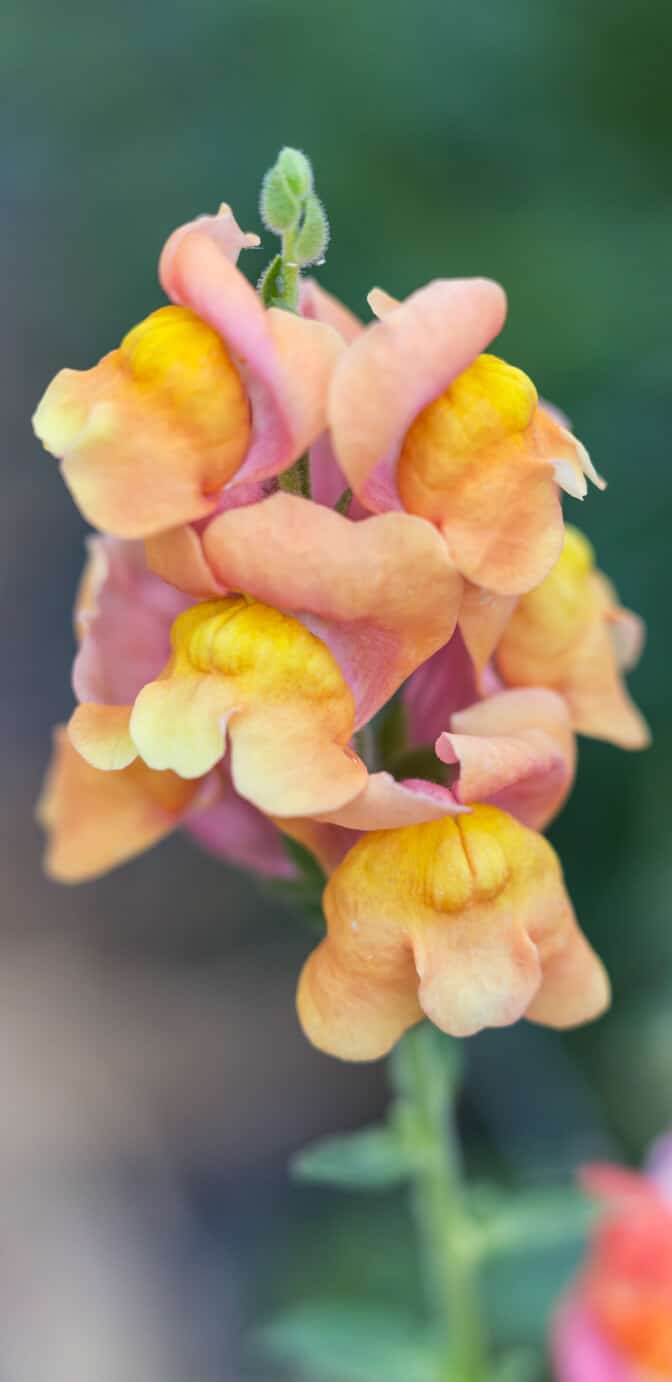
beyond the basics
-
soil and potting
Snapdragons thrive in nutrient-rich, well-draining soil like Miracle-Gro® Moisture Control® Garden Soil. For outdoor planting, choose a sunny spot with ample spacing of 6 to 12 inches. In containers, use a pot that is at least 12 inches deep and wide, providing the roots with enough space to expand and thrive. Also, make sure the pot has good drainage to keep those roots from getting waterlogged.
-
companion planting
Snapdragons are versatile plants that effortlessly blend into any garden. They complement summer blooms like petunias, lavender, and sunflowers, as well as aromatic herbs like rosemary and sage.
-
blooms
Different varieties of snapdragons have single, double, or frilly petals and come in many vibrant colours. The most common variations are tall snapdragons that feature flowers with broad petals on strong stems, dwarf snapdragons that boast delicate blooms in an array of colours on short stems, and double snapdragons which feature multiple rows of ruffled petals.
-
pest control
Snapdragons generally are resistant to pests, but it’s important to keep an eye out for aphids and thrips. If you happen to spot any of these pests, it’s recommended to employ natural methods such as using an insecticidal soap like Ortho® Bug B Gon® ECO Insecticidal Soap or rinsing the foliage thoroughly with a forceful stream of water to dislodge any potential invaders.

troubleshooting
-
why aren’t my snapdragons blooming enough?
Insufficient sunlight exposure or subpar fertility conditions. To ensure your Snapdragons thrive, ensure your plants receive a minimum of 6 hours of direct sunlight each day. To improve soil fertility, you can enhance it by incorporating a nutrient boost like Miracle-Gro® Water Soluble All Purpose Plant Food. This will enrich the environment for your plants and promote their growth. Also, to encourage the formation of new buds, try deadheading to clear up any withered blossoms.
-
why are my snapdragon’s leaves powdery?
Fungal disease. This tends to appear in warm and humid climates. To prevent and treat this condition, ensure adequate air circulation between plants by leaving sufficient space when planting, avoid wetting the foliage during watering sessions, and use fungicides if necessary.
-
why does it look like my snapdragons are wilting?
Over watering or under watering. Excess moisture can result in root rot, hindering your flowers’ ability to absorb essential nutrients. Conversely, a lack of moisture can cause your flowers to dry out or wither. To ensure optimal growth, carefully assess soil moisture levels and adjust watering practices accordingly.
-
why are my snapdragons falling over?
Insufficient sunlight. To address this, try moving the plant to a spot that ensures 6 hours of sunlight. Additionally, consider pruning the leggy stems and using supports such as stakes or trellises to help the stalks stand tall.
we all want a stunning garden, right? one awesome way to achieve this is by deadheading your flowers.
If you’re not familiar with it, deadheading means snipping off the dead or faded blooms from your plants. It not only spruces up your garden, but also helps keep your plant babies healthy and blooming for longer. So, let’s dive into everything you need to know about deadheading flowers, including why, when, and how to do it!
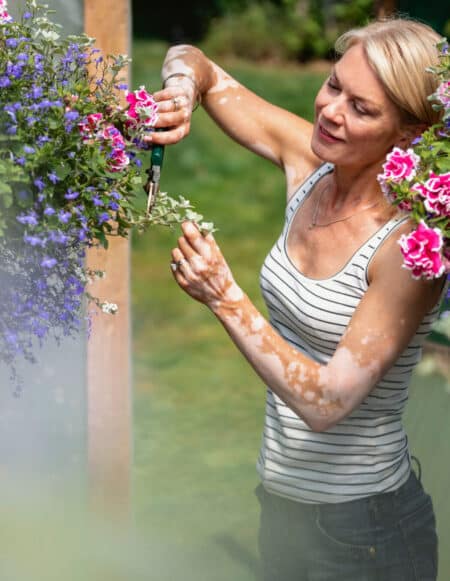
benefits of deadheading flowers
Deadheading does more than just make your garden look tidy – it can also make your blooms last longer and keep your plant healthy. It helps redirect the plant’s energy to producing more blooms instead of seeds, resulting in a fuller and healthier plant. With a healthier plant, you’ll be less likely to have to deal with pesky diseases and insects. And let’s face it, there’s just something satisfying about snipping off dead and fading blooms.
when should you NOT deadhead flowers?
At the start of the season, hold off on deadheading until the plant has produced a few seeds. This is most vital for plants that require their seed pods to produce new flowers in the following season, like lilies. Additionally, some plants, such as cosmos and zinnias, have a beautiful seed head that can add interest to your garden even after the blooms have faded.
Certain flowers produce deadheads that contain seeds birds love to munch on. Flowers like aster, bee balm, black-eyed susans, coneflowers, false sunflowers, gayfeather, globe thistle, ligularia, pennisetum, sedum, and sunflowers are some examples. For these flowers, resist the urge to deadhead. Leave the deadheads as nature’s snack bar for our bird friends!
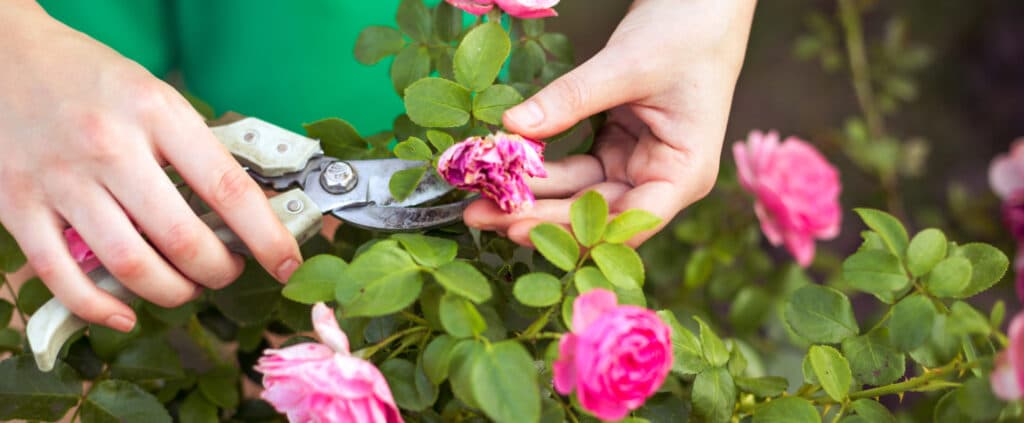
comment étêter les fleurs
Supprimer les têtes de fleurs mortes est un jeu d’enfant! C’est comme si vous donniez une petite coupe de cheveux à vos plantes, mais avec beaucoup moins de tracas. Voici comment procéder :
- Repérez la fleur morte ou fanée et faites vos adieux.
- Repérez l’endroit où vous devez couper : au-dessus de la première série de belles feuilles ou de bourgeons et en dessous de la fleur morte.
- Sortez votre beau sécateur ou vos ciseaux et commencez à couper! Attention aux bourgeons frais.
- Après avoir coupé les têtes mortes, donnez à vos plantes un peu de soin avec de l’eau et de la nourriture, pour aider vos fleurs à reprendre de la vigueur et à être encore plus belles. Pensez à utiliser un engrais comme l’Engrais pour Plantes Ultra Bloom Miracle-Gro® Shake ‘N Feed.
- Enfin, rangez et désinfectez vos outils de taille avec de l’alcool à friction. Et voilà, c’est fait : votre jardin ressemblera à un paradis fleuri en un rien de temps!
So why not try deadheading your flowers? It’s not rocket science, and there are a variety of techniques you can try until you find what works for you. You might even find it to be a relaxing and enjoyable way to connect with your garden. Give it a go and get ready to show off your beautiful garden full of healthy plants and stunning blooms!
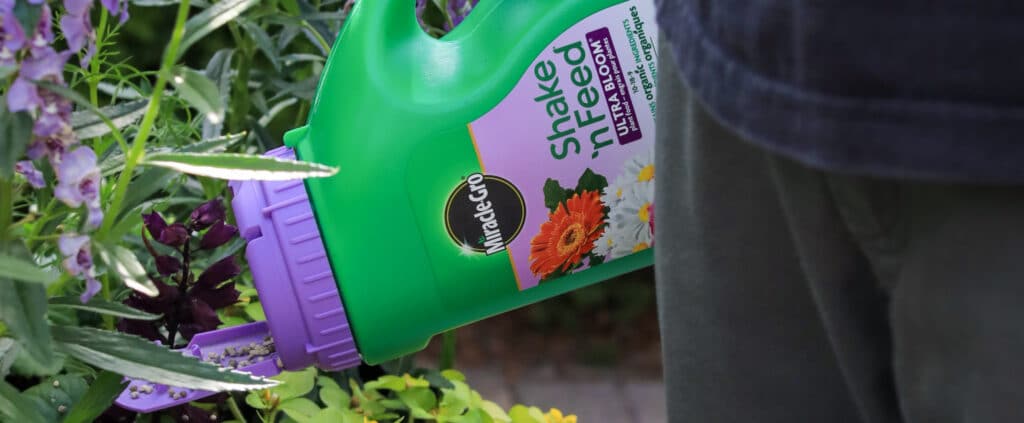
#easypeasy

mint
aka mentha
Mint is an easy, fast-growing herb that is used in drink and food recipes. It is a perennial herb that grows little white and purple flowers. There are over 30 different variations of mint, but the most commonly grown is spearmint and peppermint.
variations
Apple/Pineapple Mint, Corsican Mint, Pennyroyal, Peppermint, Citrus Mint, Spearmint
light
full sun
If the soil is nice and moist, full sun is okay. Mint can also thrive in partial shade.
water + feeding
thirsty
Should be watered at least twice a week.
toxic
no
This plant is safe for animals to nibble on.
size
small to medium
Mint can grow to between 1 – 2 feet tall.
pro tip
An effective remedy for headaches
If you are prone to tension headaches, you can make a compress out of mint leaves for your forehead or rub peppermint oil on your temples.
fun fact
Ancient origins
Mint was used in ancient Greece, Rome, and Egypt

beyond the basics
-
soil + potting
Mint does not need to be fussed over which makes it perfect for first-time gardeners. When planting your mint consider using a well-draining soil that can help with moisture control, like Miracle-Gro® All Purpose Garden Soil. This soil helps to prevent from over- and under-watering your mint plant.
-
companion planting:
Luckily, mint is an easy herb to find companion plants for. You can take your pick of popular home garden veggies such as: carrots, cabbage, kale, tomatoes, bell peppers, beans and even zucchini.
-
harvesting
Frequent harvesting is important to keeping your mint flourishing. Young leaves have more flavour than older leaves. With this in mind, you can start harvesting your mint as soon as it comes up this spring.
-
pest control
If you see your mint plant drooping, there might be a pest problem. Common pests you might see with mint plants are aphids, mealy bugs, spider mites, or flea beetles. If you are seeing curling leaves or holes in your leaves, these are tell-tale signs of pests. Don’t worry, there is an easy fix. You can use a gentle insecticide like Ortho® Bug B Gon® ECO Insecticidal Soap Ready-To-Use to safely and quickly get rid of those little nuisances.


troubleshooting
-
What do I do with my mint once I harvest it?
You’ve got options.
Once you pick a few sprigs from your mint plant, you can keep them in water for a few days. It is best to use your mint while it is fresh, about 3-5 days. If you are looking to dry your mint leaves, cut them right before flowering and let the leave air dry. Once dry, store the dried mint in an air-tight container.
Or you can just pick the leaves from your mint plant as you need them.
-
Why is my mint looking leggy?
More sunlight. Most of the time, if your mint plant is looking thin and leggy it is lacking sunlight or water or nutrients. The best way to prevent mint from getting leggy is to make sure it is growing in a warm spot that gets lots of light. Keep it in a big pot with well-draining and nutrient rich soil.
-
Why is my mint turning crispy and brown?
Under-watering. This is easy to fix. Try watering your mint on a schedule, aiming for once or twice a week. Be sure to water under the leaves and close to the soil so you don’t damage the leaves.
-
How do I know if my mint is healthy?
Healthy, ready to use mint is a deep, rich green. If your mint is yellow and falling, it is likely due to its growing conditions. Keep your mint plant in full or partial sun, with a well-draining potting mix like Miracle-Gro® All Purpose Garden Soil. Make sure you water your mint whenever the top of the soil is dry, usually about twice a week.
Whether you’ve run out of shelf space for your plant babies or are looking for a rental-friendly way to bring hanging plants into your life, a hanging plant stand can be a cute and functional addition to your space.
here’s how to turn a humble clothing rack into a minimalist plant stand
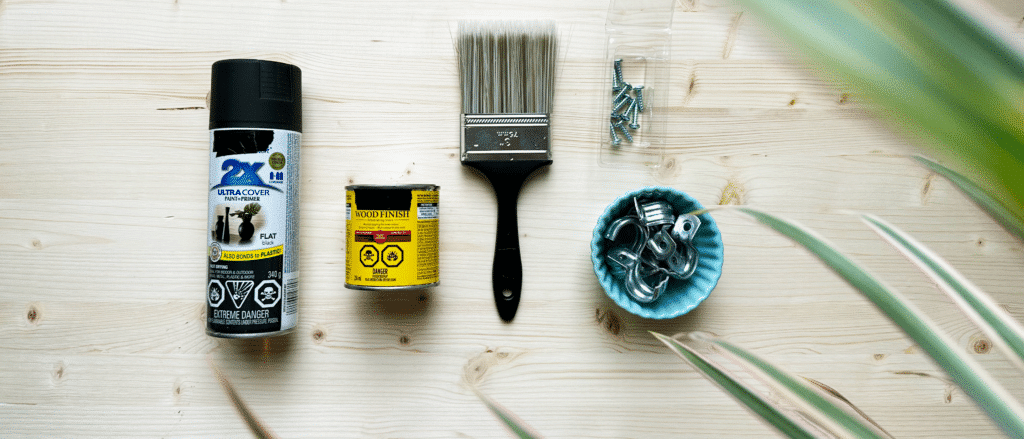
here’s what you need to get started:
- steel clothing rack (available at many big box stores)
- project panel/wood/plywood (to fit clothing rack)
- 4 EMT straps (sized to fit around pipes of the plant stand)
- 4 wood screws
- flat black spray paint (or colour of your choice)
- wood stain
- paintbrush
- drill or screwdriver
- sand paper
- saw
- pencil
- measuring tape
- hanging plants and pots
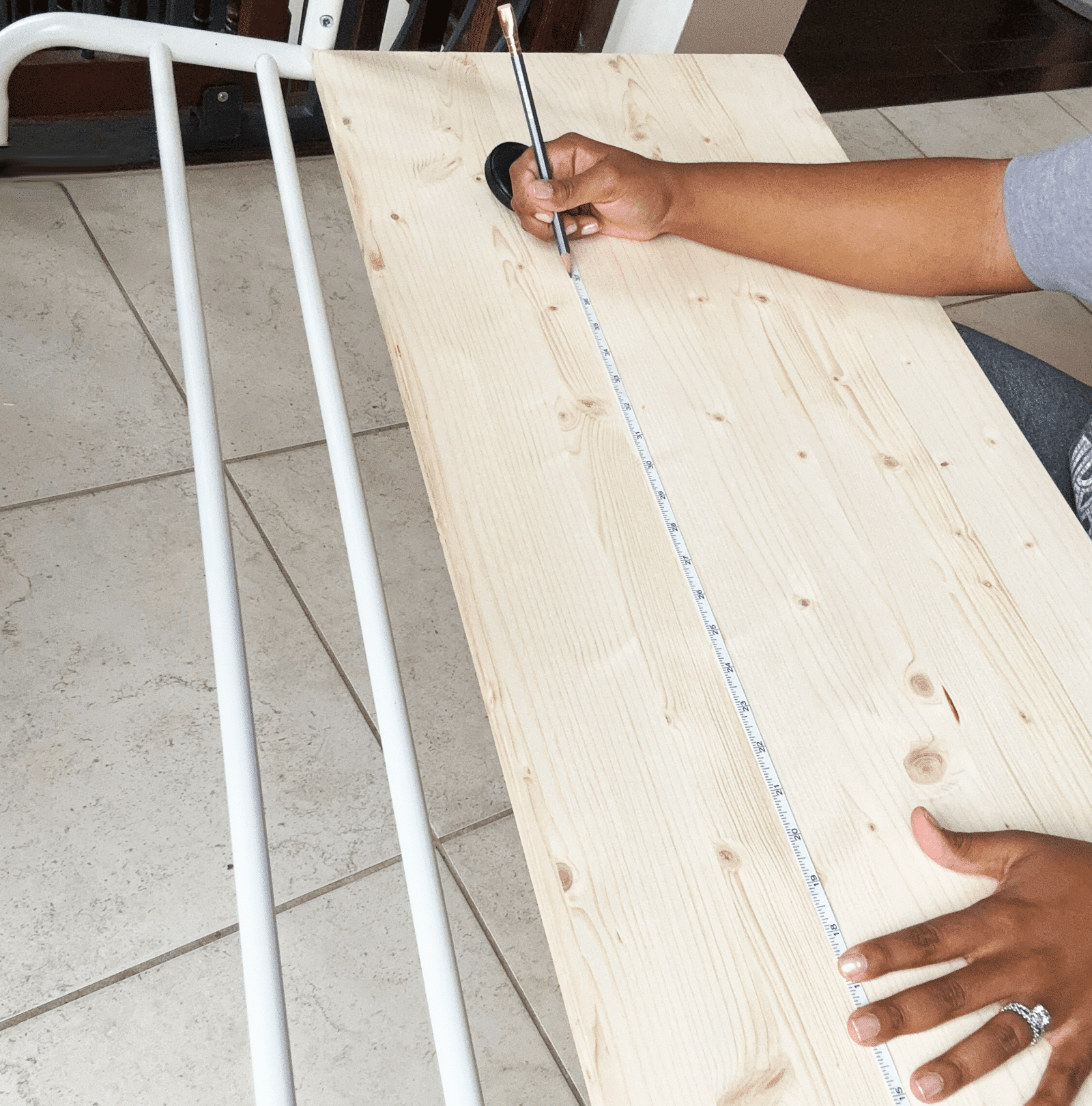
step one.
Measure the base of the clothing rack, where you will eventually add the bottom shelf, and note the dimensions. With a pencil and measuring tape, use those dimensions to mark the piece of wood where it will need to be cut to fit on the base.
step two.
Use a saw to cut along the guidelines you made in step one.
If you don’t have a saw (or aren’t comfortable using one), most major hardware stores will cut wood pieces down to size for you – just be sure to bring the exact dimensions you need!
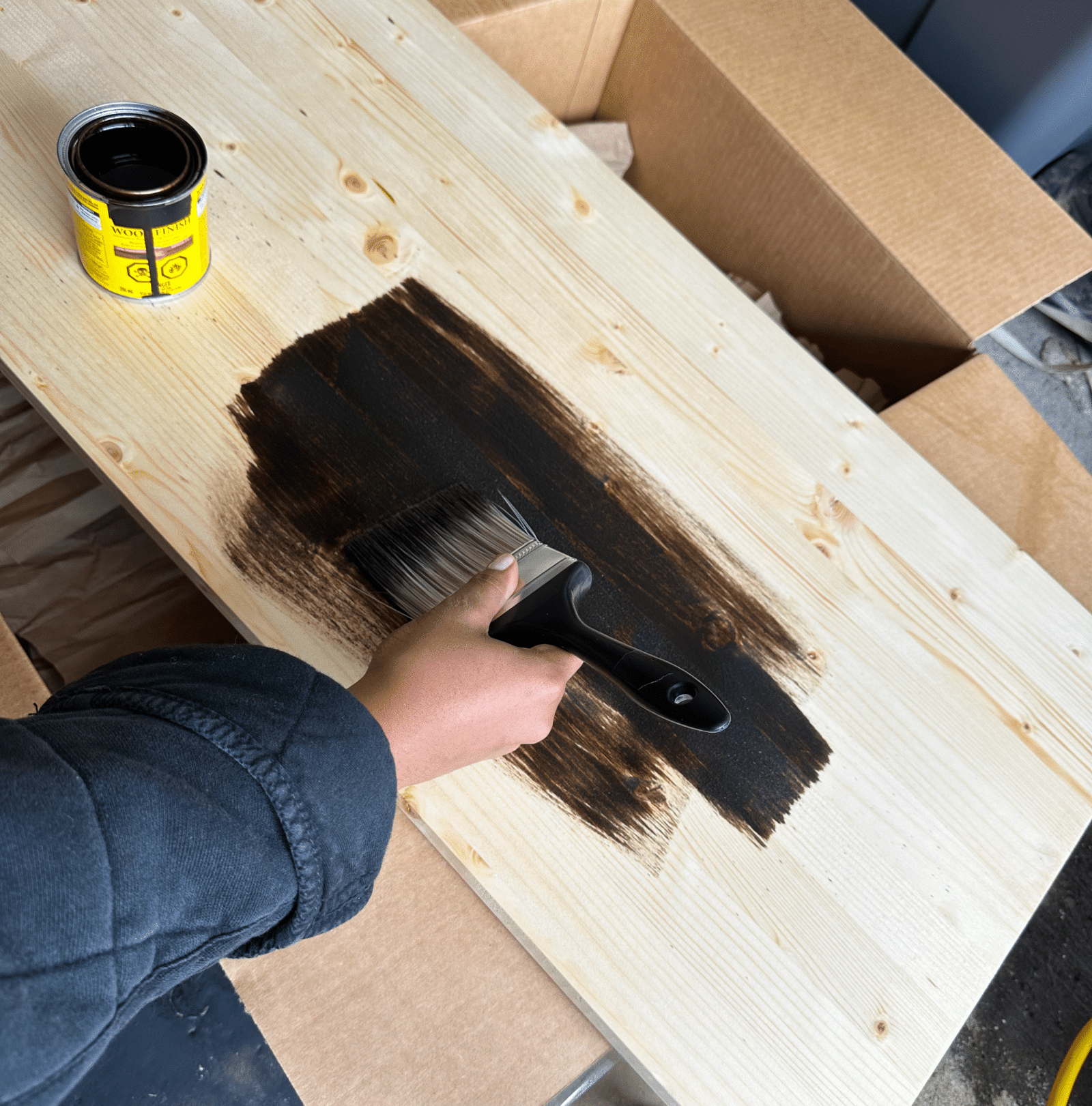
step three.
Sand any cut edges on the piece of wood.rnrnTo finish the shelf, coat it with the wood stain of your choice. Skip this step for a more boho look, or paint the shelf instead for a modern farmhouse vibe.
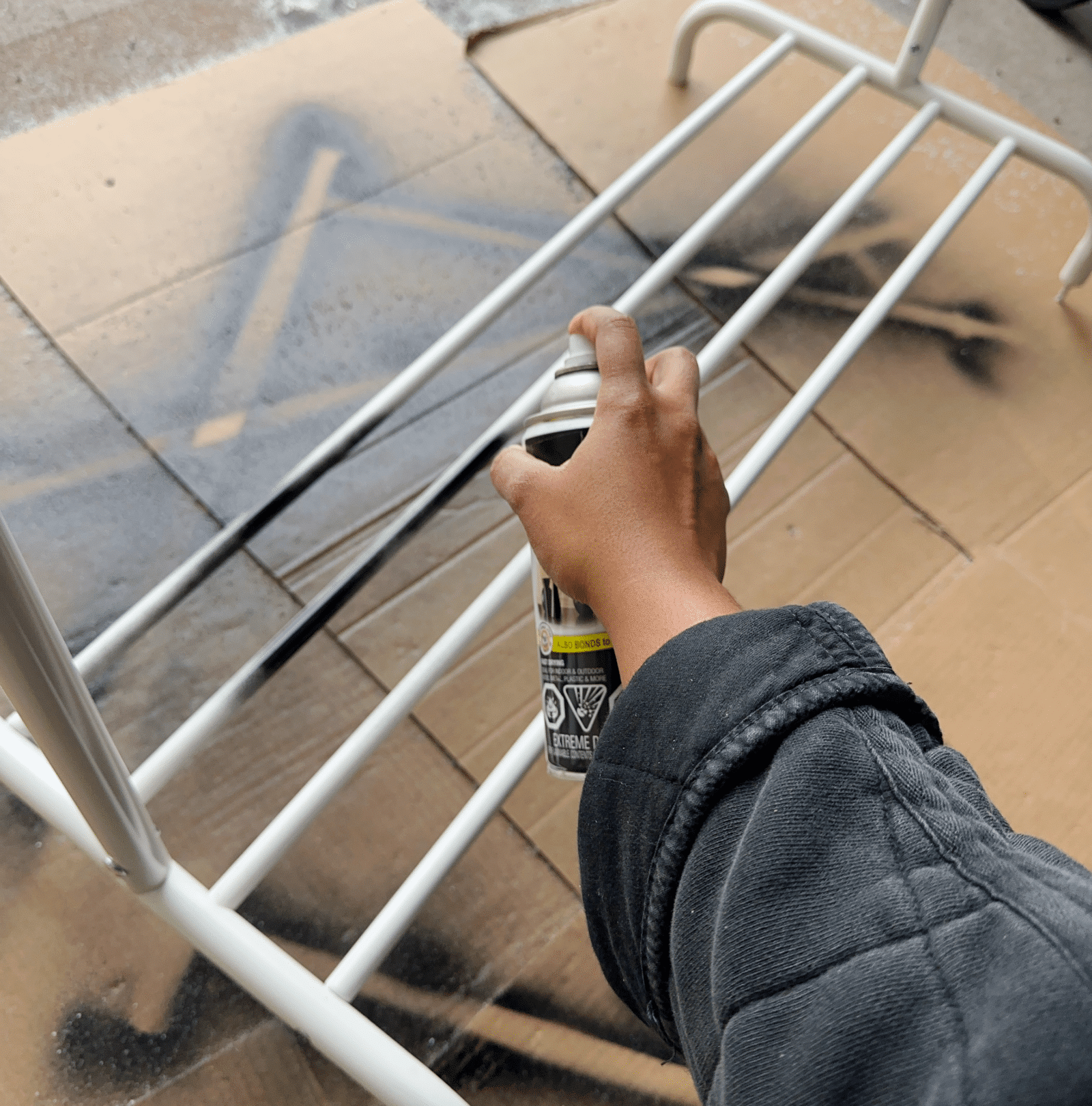
step four.
Spray paint the clothing rack. You may need to do several thin coats to ensure full coverage, letting each coat fully dry before going in with the next.
step five.
Use four EMT straps and wood screws to attach the piece of wood to the bottom shelf area of the clothing rack.
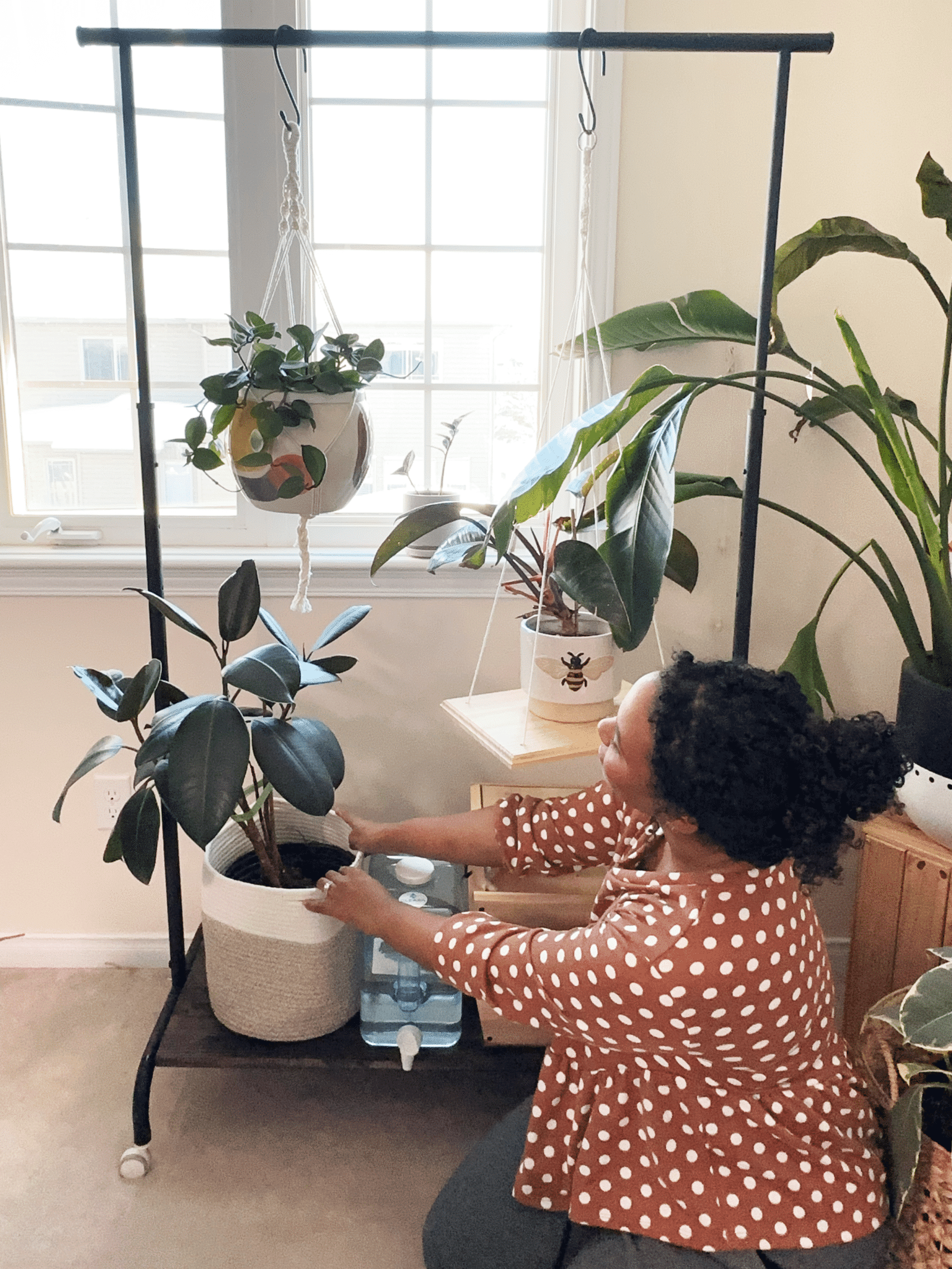
step six.
The final step – and my favourite one! – is to style your plants on your new plant stand. Place larger plants or plant care supplies on the lower shelf, and smaller hanging plants in macrame hangers from the top bar. Vary pot and basket choice to really express your style and help your new plant stand fit in with your space!
#easypeasy

alocasia
aka alocasia
The Alocasia family contains about 70 different variations. They’re tuberous perennials with long stalks. Alocasia leaves vary between being arrow and heart-shaped, and may be interestingly decorated
variations
Alocasia amazonica ‘Polly’, Alocasia amazonica ‘Bambino’, Alocasia amazonica ‘Ivory Coast’, Alocasia micholitziana ‘Frydek’, Alocasia reginula ‘Black Velvet’, Alocasia infernalis ‘Black Magic’, Alocasia rugosa ‘Melo’, Alocasia maharani ‘Grey Dragon’
light
indirect
Place in a spot where it’ll get 6 – 8 hours of indirect light.
water + feeding
not too thirsty
Water until it flows through the drainage hole.
toxic
yes
Should be kept away from your fury friends.
location
a little picky
For spaces that may not get enough light, use a grow light.
humidity
love it
They love high humidity.
size
medium
They can grow between 2 – 6 feet.
pro tip
dry as a bone?
Keep the soil pretty dry throughout the winter, giving it a little water at every 2 weeks.
fun fact
need light and dark
The short days and long nights of fall and winter are perfect for poinsettia. It’s actually what causes them to bloom.

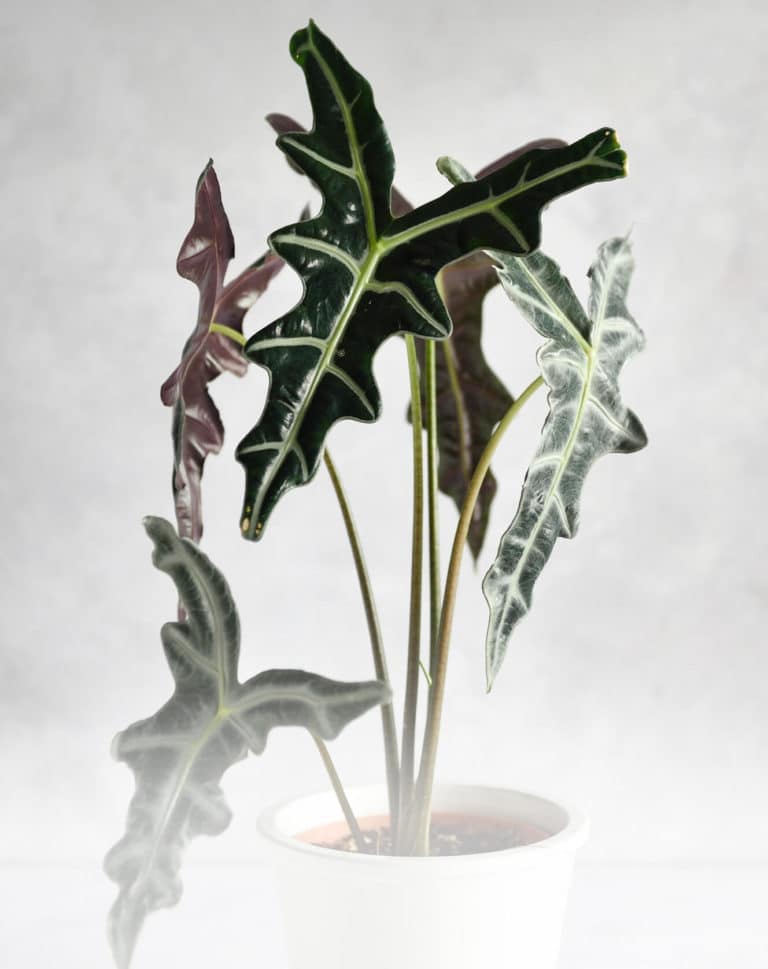
beyond the basics
-
soil + potting
Your Alocasia needs a well-draining potting mix. The Miracle-Gro® Indoor Potting Mix contains coconut coir and perlite to hold onto and release moisture as your plant needs it. If you find that your plant is wanting a little extra, you can add in some Miracle-Gro® Cactus, Palm & Succulent Potting Mix. Adding this succulent mix helps keep your soil light and airy.
-
when to repot
Like most indoor tropical plants, the best time to repot is in the spring or summer, when your plant is strong. Your alocasia will likely want to be repotted every 18 – 24 months. When you’re selecting its new pot, choose one that is about 2 – 4” bigger than its current one.
-
propagation
To propagate your alocasia, use the division method. Remove the plant from its pot and separate a small clump of roots from the main rootball. Replant the small clump into a new pot with fresh soil. Make sure it’s buried at the same depth as the original plant.
-
pest control
Your alocasia may be more prone to spidermites than your other indoor plants. To help prevent those nasty mites from appearing, make sure your plant doesn’t dry out too much over the winter. If you see spidermites on your alocasia, you can use Ortho® Bug B Gon® ECO Insecticidal Soap Ready-To-Use. Spray this insecticidal soap on your plant to eliminate those pesky mites.

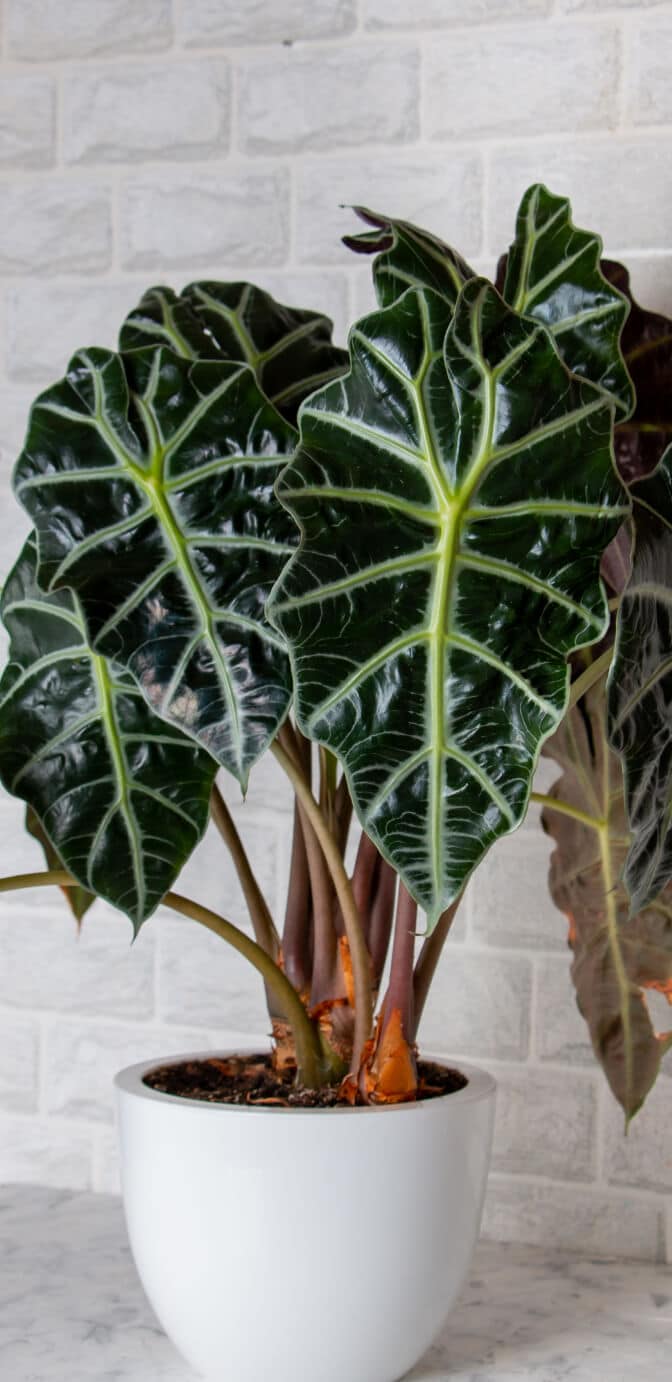
troubleshooting
-
Why are my leaves dying?
Not enough humidity or dry soil. Your alocasia could probably use a good watering. If you’re already on a watering schedule and you’re still noticing dying leaves, consider increasing the humidity in the room.
-
Why are my leaves turning yellow?
Overwatering. Allow the soil to dry out a bit before watering your plant again. For future waterings, make sure the soil is about 25-50% dry before watering.
-
Why are my leaves turning brown?
Probably a sunburn. If your alocasia is too close to bright, direct light then it’s time to move it away. Your alocasia wants to be in bright but indirect light, so find a spot that isn’t right in front of a window. If your lighting is okay, then it could be fertilizer burn. To fix this, drain any accumulated fertilizer from the potting mix, or repot with fresh soil.
-
What are these rusty spots on my leaves?
Fungal infection. Poor light and warm, humid conditions can be responsible for fungus. To prevent this make sure the leaves stay as dry as possible. Instead of overhead watering, opt for bottom watering or watering straws instead. Be sure to remove any dead, decaying or diseased plant matter from your alocasia’s pot.
